With one week in Prague, we hit the ground running trying to see and experience as much as we could in the Golden City. There were times when I was wandering down mazes of cobbles that I had to pinch myself. Is this city even real or is it a dream? We had high expectations and Prague’s beauty and charm managed to exceed all of them. Historical, bohemian, inexpensive and fun.

This is a city that is best explored on foot. The swan-filled Vltava River divides this magical city filled with rustic bridges, ancient cathedrals and walled courtyards. Chomping on hearty goulash and drinking a pint of Pilsner, which is cheaper than water, is your reward in the evening after your legs have turned to jello. If you planned on only staying a few days that’s truly a shame. After a full week we felt reluctant to leave.
The following is a list of the Top 35 things to do in Prague:
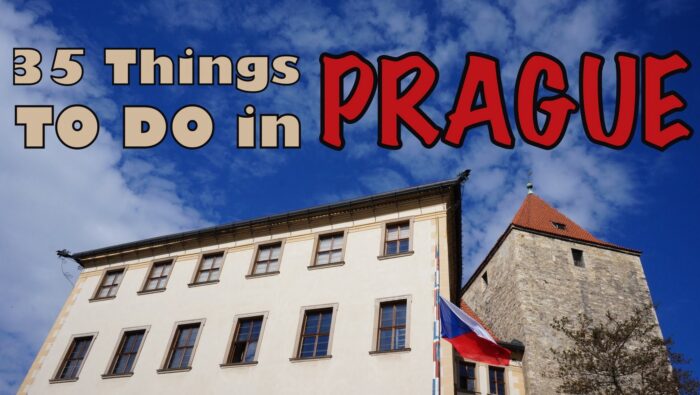
35 Things to Do in Prague: Summer Travel Guide!
Prague Photo Essay
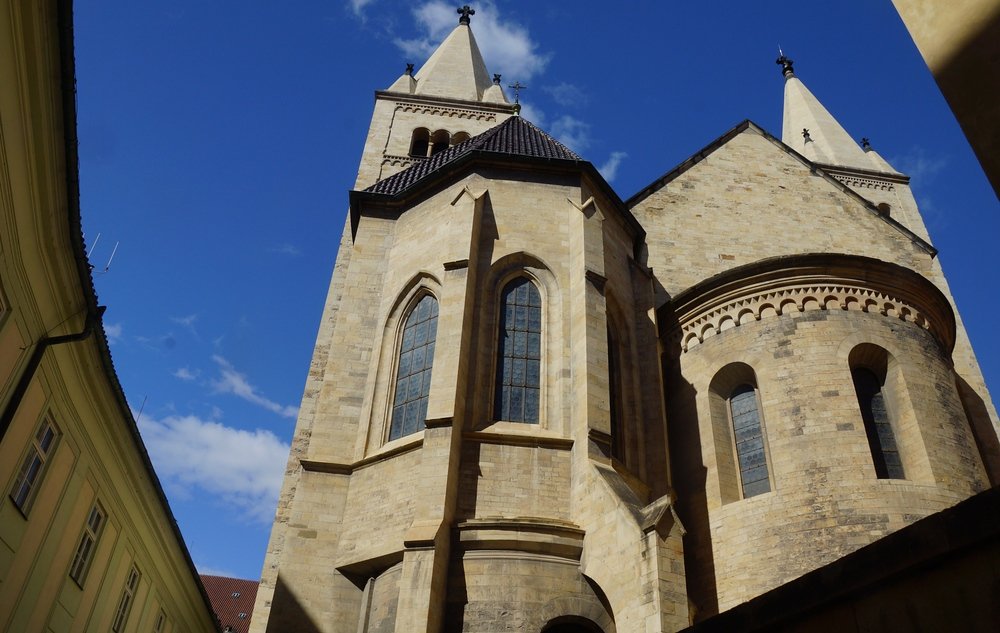
1) Prague Castle
Prague Castle is the largest ancient castle in the world and it is home to several palaces, as well as a cathedral, a basilica, and gardens. Given the entire complex is over seven times the size of a sports stadium, this 13th century charmer would take days to properly appreciate.
Some of the top highlights include visiting St. Vitus Cathedral, the Golden Lane and the tomb of St. John of Nepomuk. Although there are many activities in Prague that are free, a visit to Prague Castle is certainly worth the price of admission.
Visiting Pražský Hrad is a journey through the ages, offering a blend of Gothic, Romanesque, Baroque, and Renaissance styles. The location of Prague Castle offers some of the best views in the city. From its terraces, you can gaze out over the red-tiled roofs of Prague, the winding Vltava River, and the iconic Charles Bridge. It’s a panorama that’s especially magical at sunset.
Get There
- By Tram: Take tram numbers 22 or 23 to the Pražský hrad stop, which is right by the main entrance.
- By Metro: The closest metro station is Malostranská, followed by a short tram ride or a scenic walk.
- By Foot: For those who enjoy a walk, the route from Charles Bridge up to the castle is steep but filled with charming sights.
Visitor Tips
- Check for Events: Sometimes, parts of the castle may be closed for state events or renovations. Check the official website for the latest updates.
- Photography: Be mindful of areas where photography is not allowed, especially inside certain buildings.
- Food and Drink: There are cafes and restaurants within the castle grounds, but they can be pricey. Consider bringing your own snacks and water.
- Respect the Sites: Follow the rules and respect the historic artifacts and buildings.
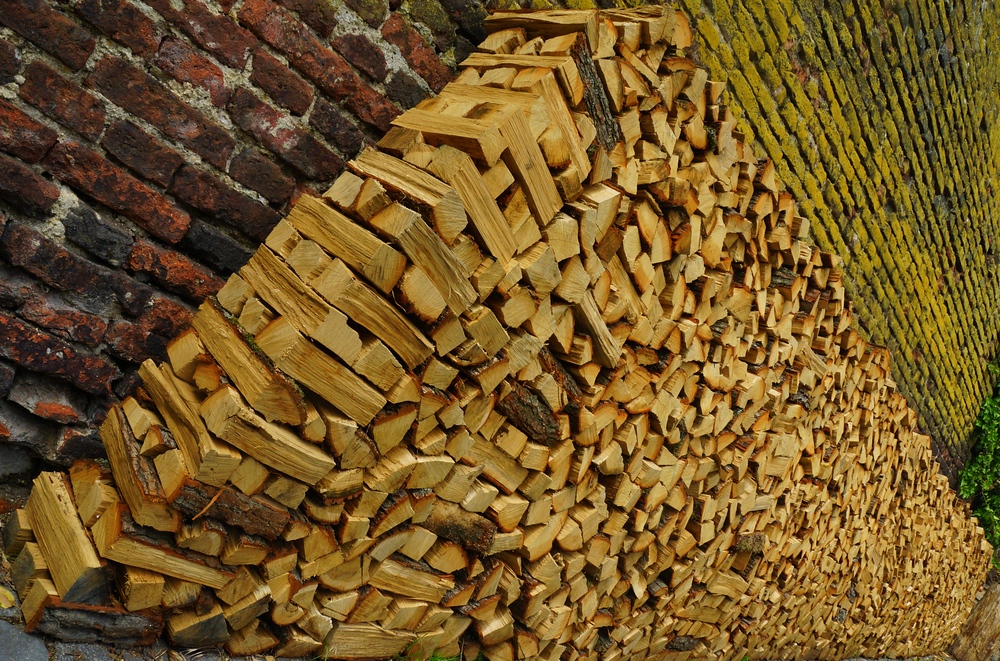
2) Novy Svet
For a quiet little escape from Prague Castle, I highly recommend wandering down Novy Svet. At one time, this cozy little neighborhood was home to servants of the Castle. With a lengthy winding cobbled street, you’ll be in the company of writers and artists who now call this neighborhood home.
Visiting Nový Svět, which translates to “New World,” is like stepping back in time. This tiny, historic street, located near Prague Castle, dates back to the 14th century. Its beautifully preserved medieval houses, many of which have quirky names and pastel colors, showcases Prague’s past.
Visiting Nový Svět feels like discovering a well-kept secret. It’s not as well-known as other tourist spots in Prague. Thus, you can explore at your own pace without the usual tourist hustle. You’ll discover cozy cafés and unique shops as you pound the cobblestone.
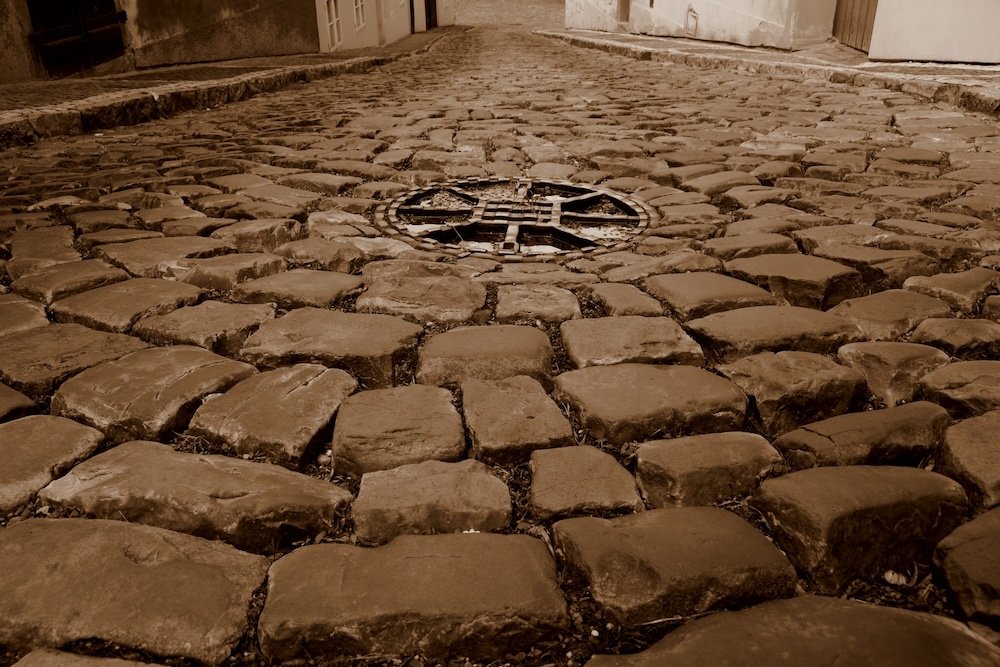
Getting There
- By Foot: Nový Svět is easily accessible on foot from Prague Castle. From the main entrance of the castle, it’s just a short walk downhill. Enjoy the scenic route and take in the views along the way.
- By Public Transport: Take tram number 22 or 23 to the Pohořelec stop. From there, it’s a pleasant walk to Nový Svět, passing by the Strahov Monastery.
Visitor Tips
- Comfortable Shoes: Wear comfortable shoes as the cobblestone streets can be uneven.
- Early Arrival: Visit early in the morning or late in the afternoon to experience the street at its most peaceful.
- Respect the Area: Be mindful that Nový Svět is a residential area. Respect the privacy of the locals and avoid making excessive noise.
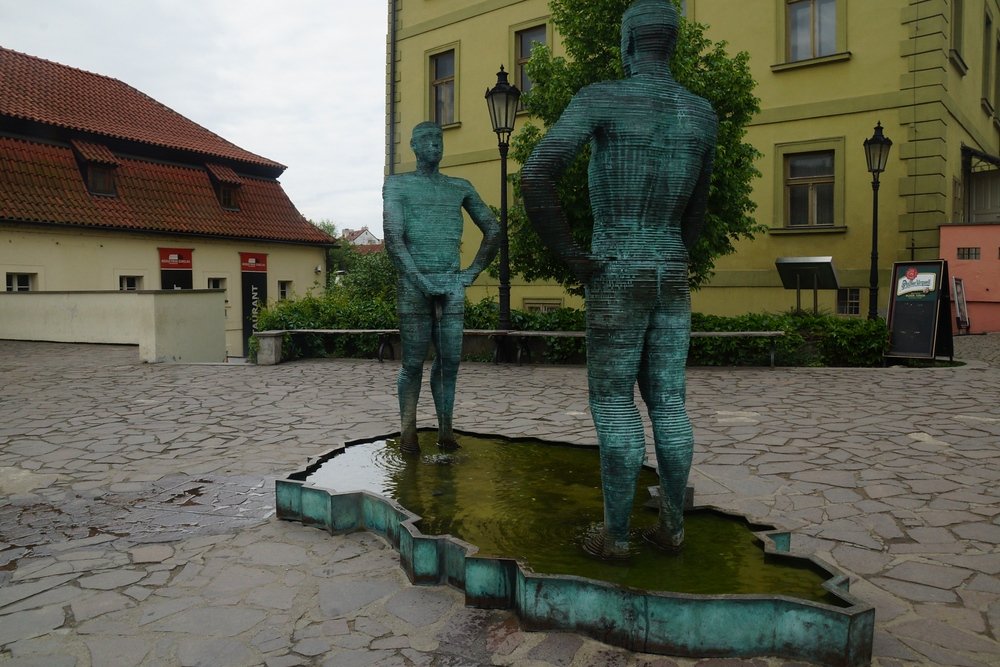
3) Kafka Museum
Franz Kafka (1883-1924) was a German language writer of novels who lived mos of his brief, anguished life in Prague. This museum is dedicated to him and his work and you’ll find some of his letters, diary entries and photographs inside. If you want to understand the mind behind “The Metamorphosis” and “The Trial,” a visit to the Kafka Museum is essential. In the courtyard you’ll notice a rather strange sculpture entitled “The Piss”. Inside you’ll find manuscripts, documents and first editions of his work displaying his often darkly paradoxical work.
The Kafka Museum isn’t your typical literary museum. It features a collection of Kafka’s original manuscripts, letters, and diaries, but what truly sets it apart is the way these items are presented. The museum uses dark, atmospheric settings, haunting soundscapes, and innovative installations to transport visitors into Kafka’s surreal world. Thus, making it a deeply immersive experience.
Kafka’s writings are often described as complex and surreal, reflecting his own troubled life. The museum provides a comprehensive look at Kafka’s personal life, his relationship with Prague, and how the city influenced his writing. You’ll learn about his family, his education, and his struggles with anxiety and illness.
One of the most striking pieces is the sculpture of two urinating men by artist David Černý, located in the museum’s courtyard. AKA the piss. It’s an example of the museum’s commitment to engaging visitors in unexpected and memorable ways.
Getting There
- Address: Cihelná 2b, 118 00 Malá Strana, Prague 1, Czech Republic.
- Public Transport: You can take tram lines 12, 20, 22, or 23 to the Malostranská stop and then walk for a few minutes.
- By Foot: If you’re exploring the city on foot, the museum is a pleasant walk from other major attractions like Charles Bridge and Prague Castle.
Visitor Tips
- Early Visit: To avoid crowds and have a more intimate experience, consider visiting the museum early in the morning.
- Take Your Time: Plan to spend a decent amount of time exploring the museum to fully appreciate the exhibits and installations.
- Explore the Area: After visiting the museum, take some time to explore the beautiful Malá Strana district. There are plenty of charming cafes, restaurants, and historic sites nearby.
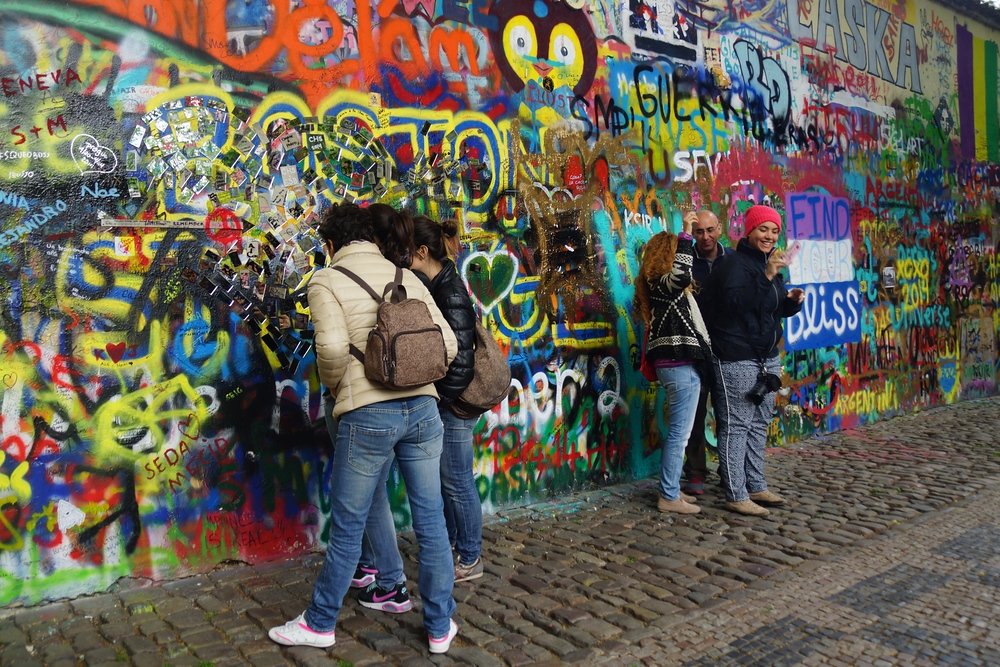
4) John Lennon Wall
Stroll along the John Lennon Wall and you’ll encounter portraits of Lennon and Yoko Ono. At one time this was just a normal wall; however, since the 1980s it has been covered by images of Lennon with Beatles song lyrics. The graffiti is always evolving, so you never know what you’ll find. The wall represents ideals associated with youth including peace and love. Admire the wall slowly or stand in front of it to take a selfie 😉
The wall became a canvas for rebellious graffiti and Beatles lyrics following John Lennon’s murder in 1980. It served as a medium for young Czechs to express their frustration with the communist regime. Today, it stands as a testament to the enduring power of art as a form of protest and expression. Each visit offers something new, as fresh layers of paint, messages, and artwork cover the previous ones. It’s a dynamic, living piece of history that you can contribute to.
Getting There
- Address: Velkopřevorské náměstí, 100 00 Praha 1, Czech Republic.
- Public Transport: Take tram lines 12, 20, 22, or 23 to the Malostranská stop and walk for about 10 minutes.
- By Foot: If you’re near Charles Bridge, it’s a short, scenic walk across the bridge to the Malá Strana side.
Visitor Tips
- Be Respectful: While adding to the wall, remember it’s a shared space. Avoid covering up important messages or artwork.
- Stay Safe: Keep an eye on your belongings, as popular tourist spots can attract pickpockets.
- Take Your Time: Spend a while reading the messages and soaking in the atmosphere. It’s a powerful place that deserves more than just a quick visit.
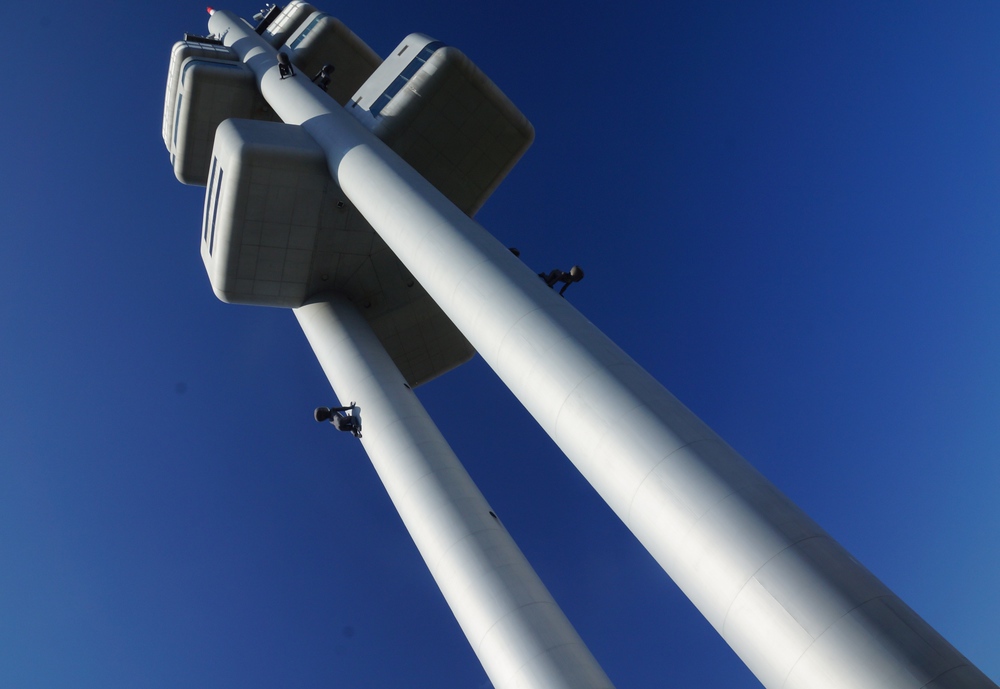
5) Prague TV Tower
One of the most distinct landmarks in the city is Prague’s TV Tower (Czech: Žižkovský vysílač). Kind of sticking out like a sore thumb, this modern tower stands tall over the city’s traditional skyline. With an unconventional design resembling a rocket, you’ll notice that there are babies crawling up and down. The local enfant terrible sculptor David Černy is also responsible for creating ‘The Piss.’
The Prague TV Tower boasts one of the most spectacular observation decks in the city. From a height of 216 meters, you get a panoramic view of Prague that’s simply unrivaled. You can see the entire cityscape, with its red rooftops, historic buildings, and the Vltava River winding through the heart of the city. On a clear day, you can even spot the distant Bohemian countryside.
This isn’t your typical TV tower. Designed in the 1980s, the Prague TV Tower is a striking example of high-tech architecture. Its futuristic design, with nine pods perched on three pillars, makes it a standout landmark. Adding to its uniqueness are the giant crawling babies sculptures by artist David Černý, which add a quirky and artistic touch to the tower.
Getting There
- Address: Mahlerovy sady 1, 130 00 Praha 3-Žižkov, Czech Republic.
- Public Transport: Take tram lines 5, 9, or 26 to the Jiřího z Poděbrad stop and walk for about 5 minutes.
- By Foot: If you’re exploring the Žižkov district, the tower is a short walk from many local attractions.
Visitor Tips
- Best Time to Visit: For the best views, visit on a clear day. Early morning or late afternoon visits provide the best lighting for photos.
- Dining Reservations: If you plan to dine at Oblaca, make a reservation in advance to ensure a table with the best view.
- Check the Weather: For the best experience, visit on a clear day to maximize visibility.
- Arrive Early: To avoid the crowds and have a more peaceful experience, try to visit early in the morning.
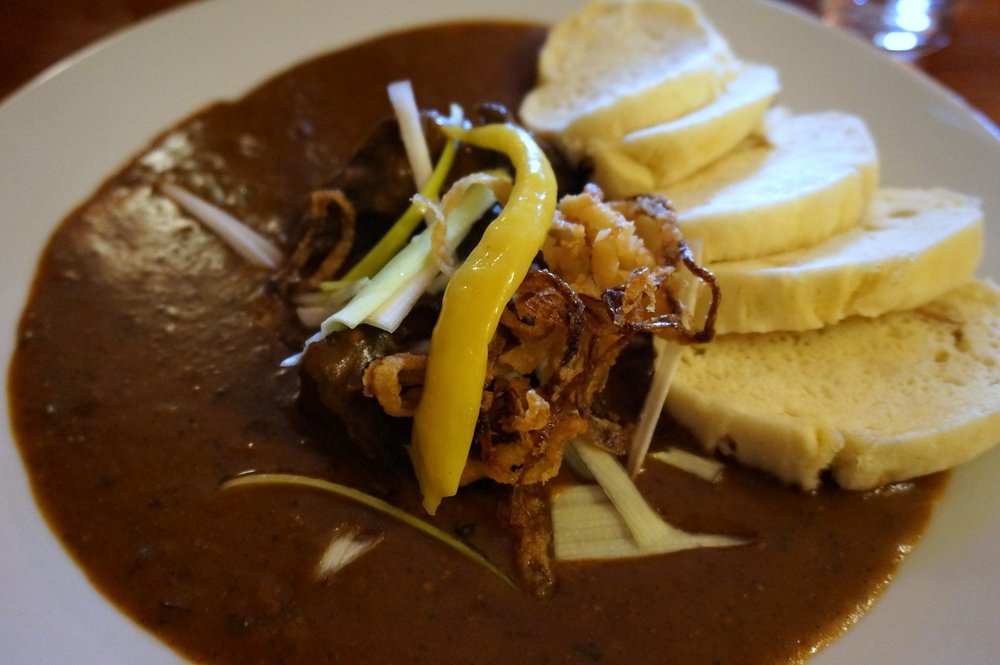
6) Czech Food: Goulash
Up next we have a heaping plate of Goulash. Goulash is actually Hungarian but the Czech Republic does have its own variety. What differs between the two is that the Hungarian is usually served with meat, noodles and vegetables and the one from the Czech Republic only has meat. I this at least once a day – while living in Prague – and it is the kind of hearty stick to your ribs meal that goes very well with a Pilsner beer.
When in Prague, indulging in a hearty bowl of goulash is an absolute must. It’s a thick, savory stew made from slow-cooked beef, onions, garlic, and a blend of spices like paprika, caraway seeds, and marjoram. The long cooking process ensures the meat is tender and the flavors are deeply infused. It results in a dish that’s rich, hearty, and incredibly satisfying.
Goulash can be enjoyed in various ways. While the traditional beef goulash is a favorite, you can also find versions with pork, venison, or even vegetarian options. It’s typically served with bread dumplings (knedlíky), but it can also come with potatoes or fresh bread. One of the great things about goulash is that it’s both affordable and filling. You get a generous portion of hearty, delicious food without blowing up your wallet.
Where to Try Goulash
- Traditional Restaurants: For an authentic experience, head to traditional Czech restaurants like Lokál, U Fleků, or U Medvídků. These spots are known for their excellent goulash and classic Czech ambiance.
- Pubs and Beer Halls: Places like Pivovarský dům and U Kalicha offer hearty goulash paired with excellent Czech beer. It’s a fantastic way to enjoy the dish in a lively, local setting.
- Street Food Markets: During food festivals or at farmers’ markets, you might find food stalls offering delicious goulash. This is a great way to try the dish in a casual, bustling environment.
Visitor Tips
- Ask for Recommendations: Locals often know the best spots for goulash, so don’t hesitate to ask for recommendations.
- Try Different Variations: While the classic beef goulash is a must, don’t shy away from trying pork or venison goulash for a different twist.
- Enjoy with Dumplings: Traditional bread dumplings (knedlíky) are the perfect accompaniment to goulash. Make sure to dip them in the sauce for the full experience.
- Take Your Time: Goulash is a dish meant to be savored. Take your time to enjoy the rich, complex flavors and the cozy atmosphere of the place you’re dining at.
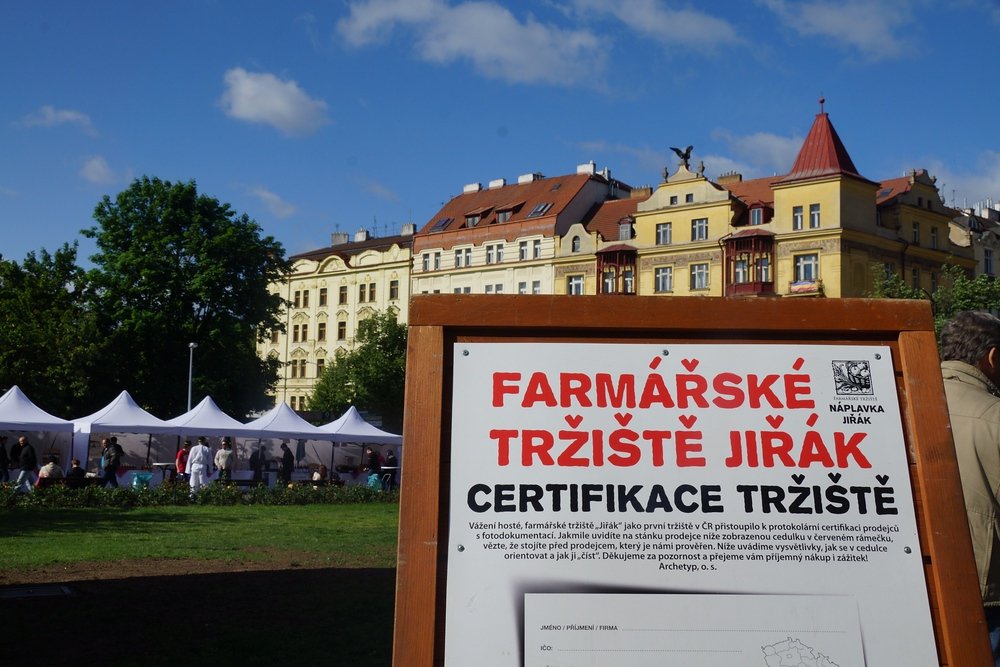
7) Saturday Market – Farmarske Trziste Jirak
You can’t visit Prague without checking out a local Farmer’s Market. We just happened to stumble across Farmarske Trziste Jirak, where we were be able to pick up some pastries, cakes, street food and organic products. It was the perfect place for a great leisurely brunch. We ended up feasting on a Balkan burger while snacking on pastries for dessert while people watching.
Visiting the Saturday Market at Farmářské Tržiště Jiřák is a quintessential Prague experience that immerses you in the local culture.You’ll find an array of fresh, locally sourced fruits and vegetables, meats, cheeses, and baked goods. Beyond fresh produce, the market is also home to a variety of artisanal products. From homemade jams and honey to handcrafted soaps and candles, the market showcases the talents of local artisans. It’s a perfect place to pick up unique souvenirs or gifts.
One of the highlights of the Saturday Market is the mouth-watering street food. You can sample traditional Czech dishes like trdelník (a sweet pastry), langoš (fried dough with garlic and cheese), and sausages, all freshly prepared on-site. There are also international food stalls, ensuring a diverse culinary experience.
Getting There
- Metro: Take the Metro Line A to Jiřího z Poděbrad station. The market is just a short walk from the station.
- Tram: Several tram lines stop nearby, including lines 11, 13, and 17. Check the tram schedules for the most convenient route.
- Walking: If you’re staying in the nearby neighborhoods, walking to the market is a pleasant option. Enjoy the local sights along the way.
- Bike: Prague is a bike-friendly city, and you can easily ride to the market. There are bike racks available near the market area.
Visitor Tips
- Early Arrival: Visit early to enjoy a more relaxed atmosphere and get the freshest picks.
- Try Local Specialties: Don’t miss out on trying traditional Czech foods like trdelník and langoš.
- Chat with Vendors: Engage with the vendors to learn more about their products and get recommendations.
- Enjoy the Music: Take a moment to listen to the live music performances that often accompany the market.
- Eco-Friendly: Bring your own bags and containers to reduce waste.

8) Prague’s Old Town Square
Prague’s Old Town is a place you can’t miss. The elegant buildings in varying pastels are a place that you’ll want to photograph. If you come early in the morning there is hardly anyone, which is in stark contrast to the afternoon when it is a sea of humans.
The square is home to some of Prague’s most significant and stunning buildings. The Gothic spires of the Church of Our Lady before Týn dominate the skyline, while the Old Town Hall boasts the world-famous Astronomical Clock. Each structure tells a tale of different eras and architectural styles.
The Old Town Square is always buzzing with activity. Street performers, musicians, and artists fill the air with lively entertainment. Seasonal markets, especially the Christmas and Easter markets, transform the square into a festive wonderland with beautifully decorated stalls offering traditional crafts, food, and drinks.
Getting There
- By Metro: Take Line A to Staroměstská station. From there, it’s a short walk to the square.
- By Tram: Tram lines 2, 17, and 18 stop at Staroměstská. Walk a few minutes to reach the square.
- By Foot: If you’re staying in the Old Town or nearby areas, the square is easily accessible by walking. Enjoy the charming streets leading up to this historic spot.
Visitor Tips
- Early Arrival: Arrive early in the morning to avoid crowds and enjoy a quieter experience.
- Stay Aware: Keep an eye on your belongings, as the square can get very crowded.
- Check the Schedule: Look up any special events or markets taking place during your visit to enhance your experience.
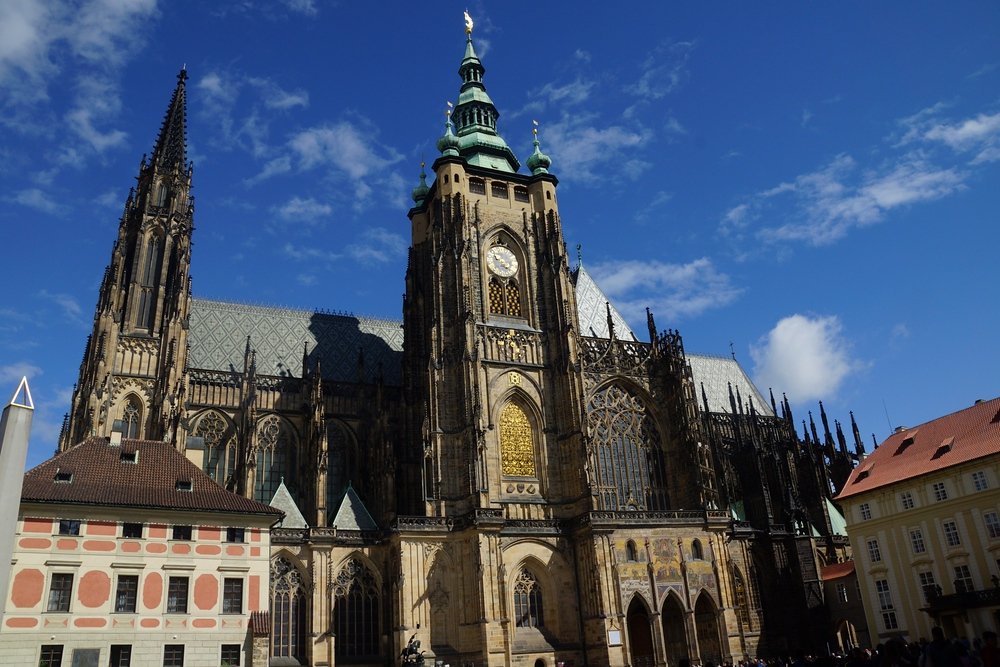
9) Saint Vitus Gothic Cathedral
Saint Vitus (Czech: Katedrála svatého Víta) is a Gothic cathedral located within the walls of Prague Castle. Inside you’ll be able to admire beautiful stained glass windows designed in the art nouveau style. The cathedral houses the tombs of many Bohemian kings and Holy Roman Emperors as main feature of the Prague Castle complex.
The first thing that strikes you about Saint Vitus Cathedral is its sheer size and grandeur. The towering spires, intricate stone carvings, and impressive flying buttresses are awe-inspiring. The detailed facade, with its statues and gargoyles, is a marvel of Gothic architecture.
Inside, the cathedral is just as breathtaking. The high vaulted ceilings, expansive nave, and magnificent stained glass windows create a sense of awe and reverence. The windows, particularly the Rose Window, are stunning works of art that flood the interior with colorful light.
For those willing to climb the 287 steps to the top of the Great South Tower, the reward is a panoramic view of Prague that is simply unmatched. From this vantage point, you can see the red rooftops, winding Vltava River, and the sprawling cityscape.
Getting There
- By Metro: Take Line A to Malostranská station. From there, it’s a short walk up to Prague Castle.
- By Tram: Tram lines 22 and 23 stop at Pražský hrad. The cathedral is within the castle complex.
- By Foot: If you’re staying in the Old Town or nearby areas, you can walk to the castle and enjoy the scenic route.
Visitor Tips
- Early Arrival: Visit early to avoid crowds, especially during peak tourist seasons.
- Dress Appropriately: As a place of worship, ensure you dress modestly. Shoulders and knees should be covered.
- Photography: Check the rules on photography. Flash photography might be prohibited inside the cathedral.
- Respect the Space: Maintain a respectful demeanor, as the cathedral is an active place of worship.
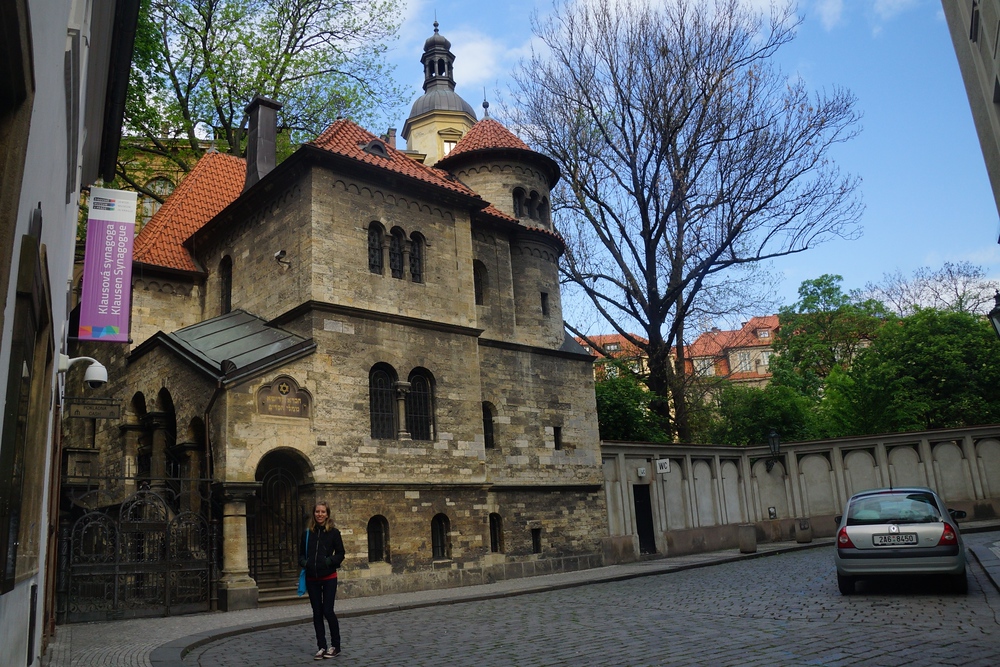
10) Jewish Quarter
If you keep going north from the Old Town Square you’ll find yourself in the Jewish Quarter of Josfov (German: Josefstadt). Completely surrounded by the Old Town, this district was preserved during Nazi German occupation with the intention of being made into a museum of an extinct race. Today, you’ll be able to many architecturally stunning synagogues.
The Jewish Quarter is one of the oldest and most well-preserved Jewish districts in Europe. Its history dates back to the 10th century, and the area has witnessed significant events that have shaped the Jewish community in Prague.
The district is home to some of Prague’s most stunning architectural works. The Old-New Synagogue, built in the 13th century, is the oldest active synagogue in Europe and a masterpiece of Gothic architecture. The Spanish Synagogue, with its Moorish Revival style, and the Pinkas Synagogue, which now serves as a memorial to Holocaust victims, are equally impressive.
A visit to the Jewish Quarter is incredibly educational. The synagogues, museum, and cemetery offer detailed exhibitions and displays that provide a thorough understanding of Jewish history and culture. It’s a chance to learn about the resilience and contributions of the Jewish community in Prague.
Getting There
- By Metro: Take Line A to Staroměstská station. The Jewish Quarter is a short walk from there.
- By Tram: Tram lines 17 and 18 stop at Právnická fakulta, which is close to the Jewish Quarter.
- By Foot: From Old Town Square, it’s just a few minutes’ walk to reach the district.
Visitor Tips
- Respect the Sites: Remember that many sites in the Jewish Quarter are places of worship and remembrance. Maintain a respectful demeanor.
- Photography Rules: Be mindful of photography restrictions, especially in the synagogues and cemetery.
- Early Arrival: To avoid crowds, try to visit early in the morning.
11) KGB Museum
On a rainy afternoon you should consider the KGB Museum as one of the more quirky attractions in the city. Inside the KGB Museum you’ll find old propaganda as well as some unusual pieces like a copy of Lenin’s death mask, the radio from Beria’s cabinet and Trotsky murder weapon.
The KGB Museum houses an impressive collection of original artifacts from the Soviet era. You’ll find everything from spy cameras and hidden weapons to secret recording devices and KGB uniforms. Each item tells a story of espionage, subterfuge, and the intense secrecy that defined the Cold War era.
Unlike many traditional museums, the KGB Museum encourages interaction. Visitors can handle some of the spy gadgets and see firsthand how they were used. This hands-on approach makes the experience more immersive and tangible, adding an element of excitement to your visit.
Getting There
- By Metro: Take Line A to Malostranská station. The museum is a short walk from there.
- By Tram: Tram lines 12, 15, 20, and 22 stop at Malostranské náměstí, which is close to the museum.
- By Foot: From Charles Bridge, it’s just a few minutes’ walk to reach the museum.
Visitor Tips
- Book in Advance: Due to its small size, the museum can fill up quickly. Booking in advance ensures you get a spot on a guided tour.
- Respect the Artifacts: While some exhibits are interactive, remember to handle them with care and respect the museum’s rules.
- Ask Questions: Engage with the guide and ask questions. The more curious you are, the more you’ll get out of the experience.
- Stay Informed: Keep an eye on the museum’s website or social media for any special events or temporary exhibits that might enhance your visit.

12) Golden Lane
The Golden Lane (Czech: Zlatá ulička) gets its name because legend has it that Emperor Rudolph was a fan of alchemy. He had alchemists working tirelessly to find a way to turn metal into gold, and to find the secret to eternal life. Dotted with tiny colored homes, you’ll find a museum of armory as one of the top highlights.
Golden Lane’s picturesque charm lies in its quaint, brightly colored houses. These small, charming dwellings, originally built in the 16th century for castle guards, later became home to artists, writers, and goldsmiths. Each house has been meticulously preserved or restored.
One of the most intriguing aspects of Golden Lane is its rich tapestry of legends and stories. It is said that alchemists once worked here, trying to turn base metals into gold, giving the lane its name. These captivating tales add a layer of mystique and wonder to your visit, making it feel like a journey through a fairy tale.
Many of the houses on Golden Lane have been transformed into small museums and exhibits, each showcasing a different aspect of life in Prague over the centuries. You can explore homes that belonged to famous residents like writer Franz Kafka, who lived here for a short period. The exhibits include period furnishings, medieval armor, and even alchemical laboratories.
Getting There
- By Metro: Take Line A to Malostranská station. From there, it’s a short walk up the hill to Prague Castle.
- By Tram: Tram lines 22 and 23 stop at Pražský hrad (Prague Castle). From the stop, it’s a brief walk to the castle entrance.
- On Foot: If you’re in the Lesser Town (Malá Strana), you can walk up the hill to the castle, enjoying the beautiful views along the way.
Visitor Tips
- Photography: Don’t forget your camera! Golden Lane offers countless photo opportunities.
- Guided Tours: Consider joining a guided tour for detailed historical insights and stories.
- Respect the Site: Be mindful of the preservation efforts. Avoid touching artifacts and follow all posted guidelines.
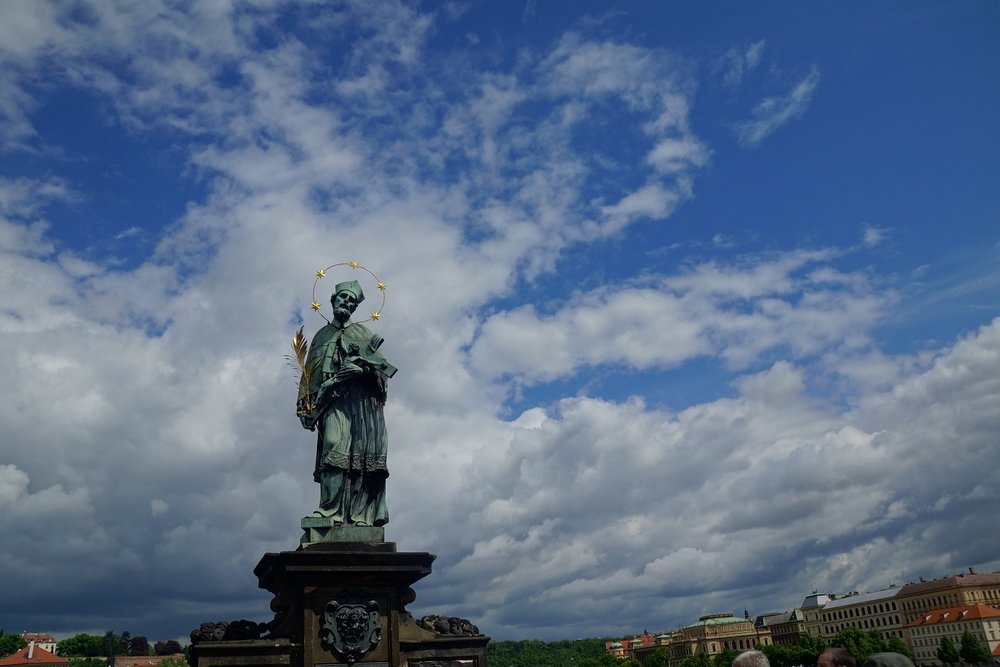
13) Charles Bridge
Charles Bridge (Czech: Karlův most) is one of the most popular historic landmarks in the city crossing the Vltava river in Prague. If you walk across during the day, you’ll find musicians, artists, and vendors selling souvenirs. Marvel at the Old Town bridge tower, considered to be a magnificent example of civil gothic-style buildings in the world. Also, be sure to compare and contrast the bridge early in the morning versus mid-afternoon. It is astonishing how quiet and busy it is during these two distinct times in the day.
Karlův most has been a vital part of Prague’s history since its construction in 1357 under the reign of King Charles IV. The bridge, adorned with 30 baroque statues of saints, stands as a testament to the city’s medieval past.
The views from Charles Bridge are nothing short of spectacular. From the bridge, you can see the majestic Prague Castle, the spires of St. Vitus Cathedral, and the picturesque rooftops of the Old Town. Whether it’s dawn, dusk, or night, the bridge offers breathtaking panoramas that are perfect for photography.
Getting There
- By Metro: The closest metro station is Staroměstská on Line A. From there, it’s a short walk to the bridge.
- By Tram: Take tram lines 17 or 18 to the Karlovy lázně stop, which is just a few minutes away from the bridge.
- On Foot: Charles Bridge is easily reachable on foot from Old Town Square and Prague Castle.
Visitor Tips
- Best Viewing Points: Climb the Old Town Bridge Tower or the Lesser Town Bridge Tower for panoramic views.
- Engage with Local Artists: Buy a piece of artwork from the local artists as a unique souvenir and enjoy live performances by street musicians, leaving a tip to support their talent.
- Photography Tips: Visit at sunrise or sunset for the best light and fewer crowds. Experiment with different angles to capture the bridge’s beauty and the cityscape.
- Respect the Bridge: Avoid touching the statues to help preserve their condition. Dispose of any trash properly and help keep the bridge clean.
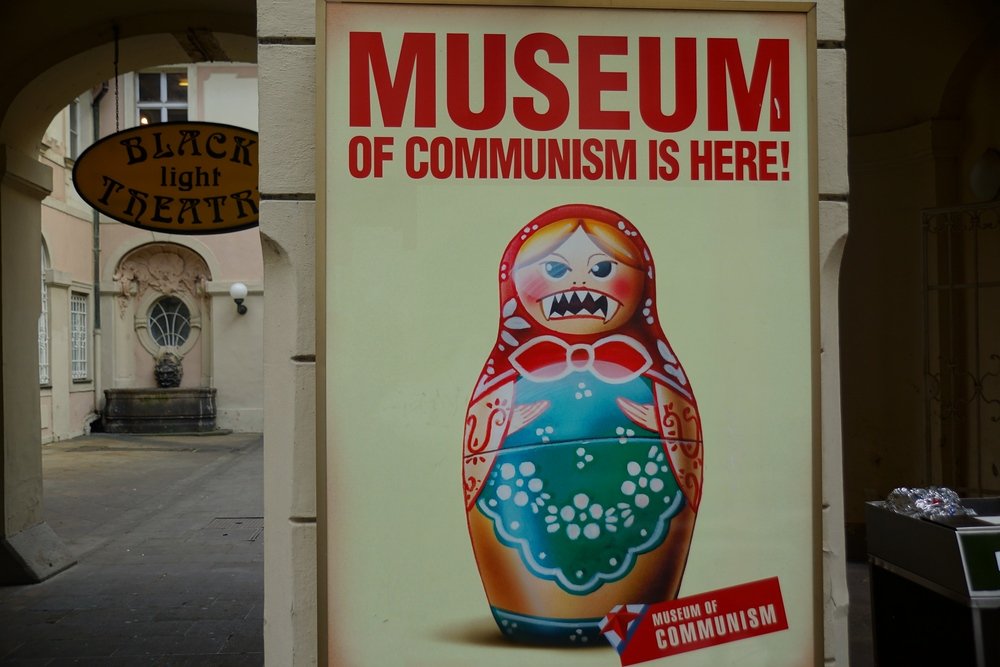
14) Prague’s Museum of Communism
Prague’s museum of Communism (Czech: Muzeum komunismu) takes a look at the post–World War II Communist regime in former Czechoslovakia. Expect to see lots of posters heavy on propaganda, genuine artifacts and multimedia presentations. Fascinating is the origins of this museum founded by American businessman and Prague bagel extraordinaire Glen Spicker. Much of the collection in the museum was gathered by him at flea markets around the city.
The Museum of Communism dives deep into the history of the communist era in Czechoslovakia, from the post-World War II takeover to the Velvet Revolution in 1989. The exhibits cover various aspects of daily life, political repression, and the struggle for freedom, offering a comprehensive look at this tumultuous period.
The museum’s exhibits are designed to be both informative and engaging. You’ll find a mix of multimedia presentations, artifacts, and reconstructed scenes that vividly depict life under communism. From propaganda posters and military uniforms to everyday household items, each exhibit is unique.
Getting There
- Address: V Celnici 1031/4, 110 00 Nové Město, Prague
- By Metro: Take Line B to Náměstí Republiky and walk a short distance to the museum.
- By Tram: Use tram lines 6, 8, 15, or 26, getting off at Náměstí Republiky.
Visitor Tips
- Audio Guide: Consider renting an audio guide for a more detailed understanding of the exhibits.
- Photography: Most areas permit photography, but always check for specific restrictions.
- Allocate Time: Plan to spend at least 1.5 to 2 hours to thoroughly explore the museum.
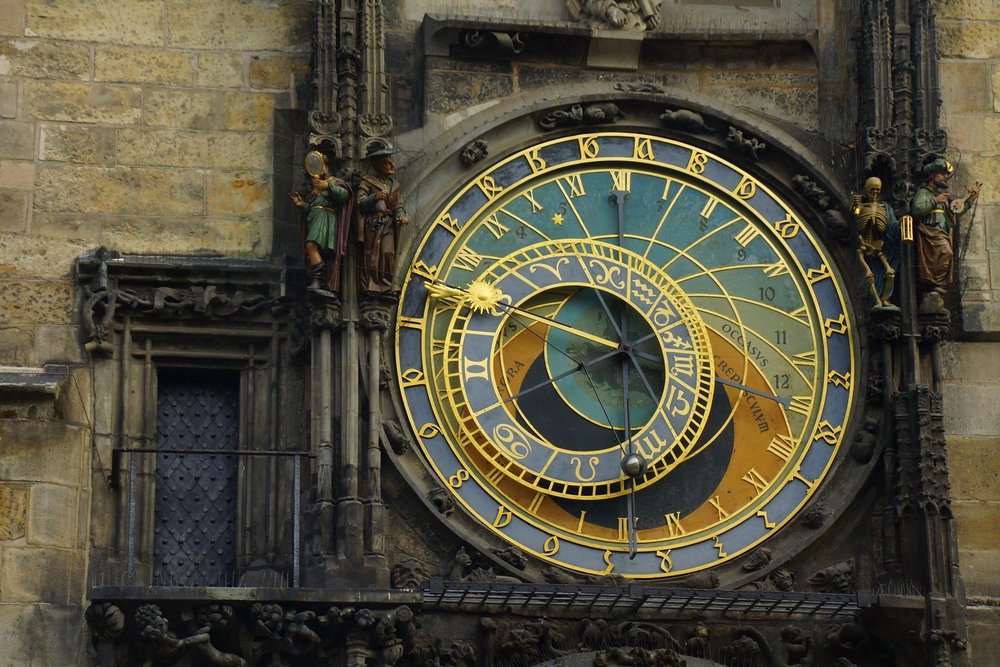
15) Astronomical Clock
When in Prague you can check out the medieval Astronomical Clock (Czech: Pražský orloj) . Founded in 1410, this third-oldest astronomical clock goes off every hour and it is right in the heart of the Old Town. Most fascinating is the skeleton ringing the bell.
The Astronomical Clock dates back to 1410, making it the third-oldest astronomical clock in the world and the oldest one still in operation. Its intricate design and complex mechanisms reflect the advanced scientific knowledge of the medieval period. The clock has been meticulously maintained and restored over the centuries.
What sets the Astronomical Clock apart is its elaborate mechanism. It not only tells the time but also displays astronomical details such as the positions of the sun and moon, and even the current zodiac sign. The clock’s face is a work of art, with moving parts and detailed figures that come to life every hour.
Every hour, on the hour, the Astronomical Clock puts on a mesmerizing show. A small trapdoor opens, and the Twelve Apostles march out, while other figures such as the skeleton (representing Death) ring the bell. Crowds gather in anticipation to witness this spectacle.
Getting There
- Address: Old Town Square, 110 00 Prague 1
- By Metro: Take Line A to Staroměstská station.
- By Tram: Use tram lines 2, 17, or 18 and get off at Staroměstská.
Visitor Tips
- Arrive Early: Arrive 10-15 minutes before the hour to secure a good viewing spot.
- Be Aware of Crowds: The area can get crowded, especially during peak tourist seasons.
- Explore the Surroundings: Take time to explore the Old Town Square and nearby attractions.
- Check the Schedule: Verify that the clock is operational during your visit, as it occasionally undergoes maintenance.
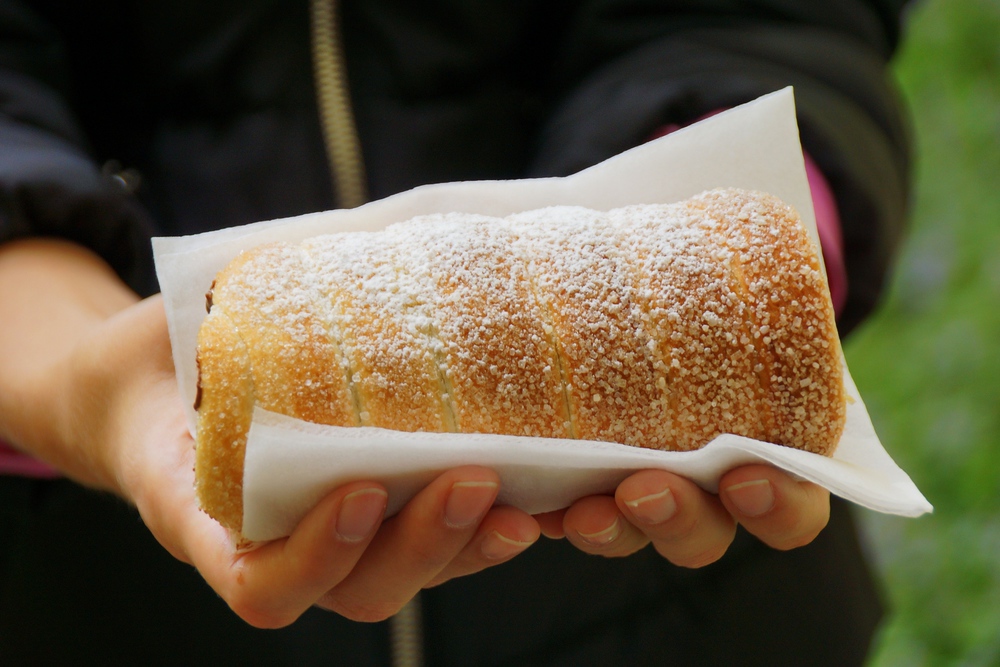
16) Czech Street Food: Trdelník
You can’t come to Prague and not sample the street food. One particularly popular item is the Trdlenik (Czech: Trdelník). You can order it with icing sugar, or if you’re feeling adventurous, ask for nutella on the inside. It is fascinating to watch it made: rolled dough wrapped around stick, grilled and covered in a sugary walnut mix. As one of the most popular street food snacks in Prague, you’ll have no problem finding a stall selling these.
This traditional Czech pastry, often referred to as a “chimney cake,” is made from rolled dough, wrapped around a stick, then grilled and topped with sugar and walnut mix. The result is a golden, crispy pastry that’s warm and sweet. The outside is crunchy, while the inside remains soft and fluffy, creating a perfect texture combination. It can be enjoyed plain or filled with various delicious fillings such as Nutella, whipped cream, or ice cream.
Watching Trdelník being prepared is almost as enjoyable as eating it. Street vendors often display the entire process, from rolling the dough to grilling it over an open flame. The cylindrical pastries spinning and caramelizing on the grill are a sight to behold.
Finding Trdelník Vendors
- Old Town Square: Numerous stands around this historic square.
- Charles Bridge: Vendors often set up near the bridge, a perfect spot to enjoy your Trdelník with a view.
- Wenceslas Square: Another hotspot for street food, including Trdelník.
Choosing Your Trdelník
- Classic or Filled: Decide whether you want the traditional Trdelník or one filled with extras like Nutella, ice cream, or whipped cream.
- Customization: Many vendors offer additional toppings, so feel free to customize your treat.
Visitor Tips
- Freshness: Opt for vendors where you can see the Trdelník being freshly prepared. It tastes best when it’s hot off the grill.
- Sharing: If you’re traveling with friends or family, consider sharing different variations to try more flavors.
- Explore Different Stands: Different vendors might offer unique takes on Trdelník, so don’t hesitate to try more than one.
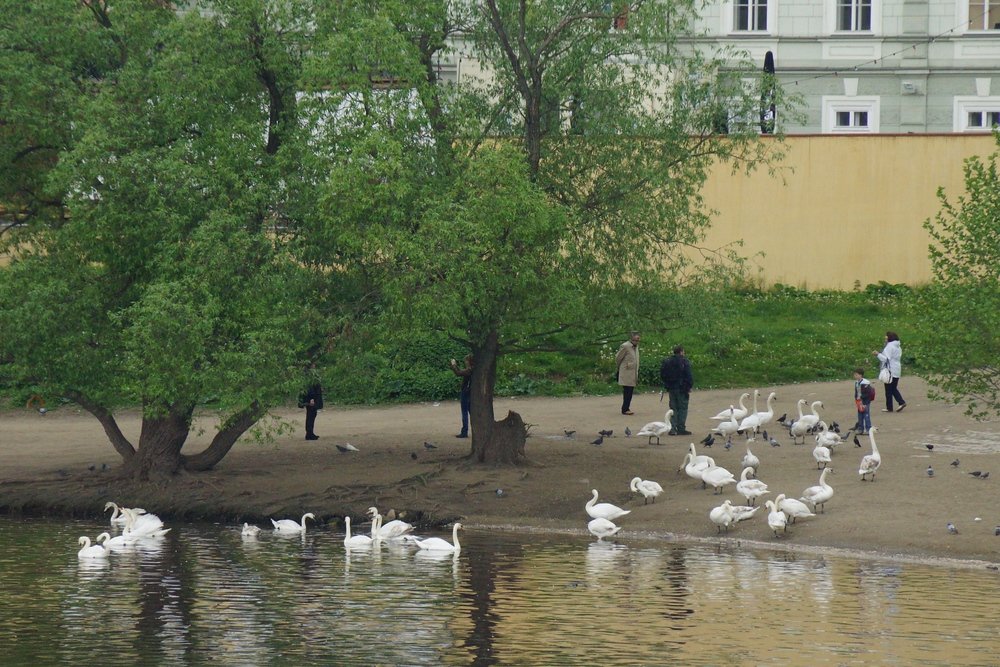
17) Feed Swans
Now one of the things I love the most about travel is the unexpected surprises. We didn’t have this particular activity on our schedule but here we are out feeding swans. They’re obviously very used to human contact as we were able to get up close without them feeling intimated.
Feeding swans by the Vltava River is a serene and memorable activity in Prague. The calm waters, coupled with the graceful movements of the swans, create a peaceful ambiance. As you feed these majestic birds, you’ll be enveloped in a sense of tranquility.
This activity is perfect for families. Children will be delighted by the chance to feed and observe the swans. It’s an educational experience that fosters a love for nature and wildlife. Plus, it’s a gentle and relaxing way to spend time together.
Location
- Best Spots: Head to the riverbank near the Charles Bridge or Kampa Park for the best swan-feeding spots. These areas are easily accessible and popular among both locals and tourists.
- Timing: Early morning or late afternoon is ideal for feeding swans. These times are less crowded, offering a more peaceful experience.
Getting There
- Public Transport: Take the metro or tram to the Malostranská or Staroměstská stations. From there, it’s a short walk to the riverbank.
- Walking: If you’re in the city center, walking to the river is a pleasant stroll with plenty of sights to enjoy along the way.

18) Funicular
For really great views of the city you can consider taking the funicular up the hill. However, we ended up walking because the line was really long at the time. Whether walking or taking the tram, it is well worth your time making it to the top for some of the most spectacular views of Prague.
The funicular journey up Petřín Hill offers breathtaking panoramic views of Prague. As you ascend, you’ll see the city’s red rooftops, the majestic Vltava River, and iconic landmarks like Prague Castle and the Charles Bridge. It’s a visual feast that makes the ride truly unforgettable.
The funicular itself is a piece of history. In operation since 1891, it combines old-world charm with modern convenience. Riding this historic funicular gives you a sense of nostalgia.
At the top of Petřín Hill, a plethora of attractions awaits. You can explore the Petřín Lookout Tower, which resembles a mini Eiffel Tower, or wander through the enchanting Mirror Maze. The beautiful rose gardens and lush greenery provide a peaceful retreat from the city’s hustle and bustle.
Location
- Starting Point: The funicular departs from the Újezd station in the Malá Strana (Lesser Town) district. It’s conveniently located and easy to find.
- Timing: The funicular operates from early morning until late evening. Check the schedule in advance to plan your visit.
Getting There
- Public Transport: Take trams 9, 12, 15, 20, or 22 to the Újezd stop. The funicular station is just a short walk from the tram stop.
- Walking: If you’re staying in the city center, walking to the Újezd station is a pleasant stroll through some of Prague’s most charming neighborhoods.
Visitor Tips
- Respect the Area: Keep the area clean by disposing of your trash properly.
- Check for Maintenance: Occasionally, the funicular may be closed for maintenance. Check ahead to avoid disappointment.
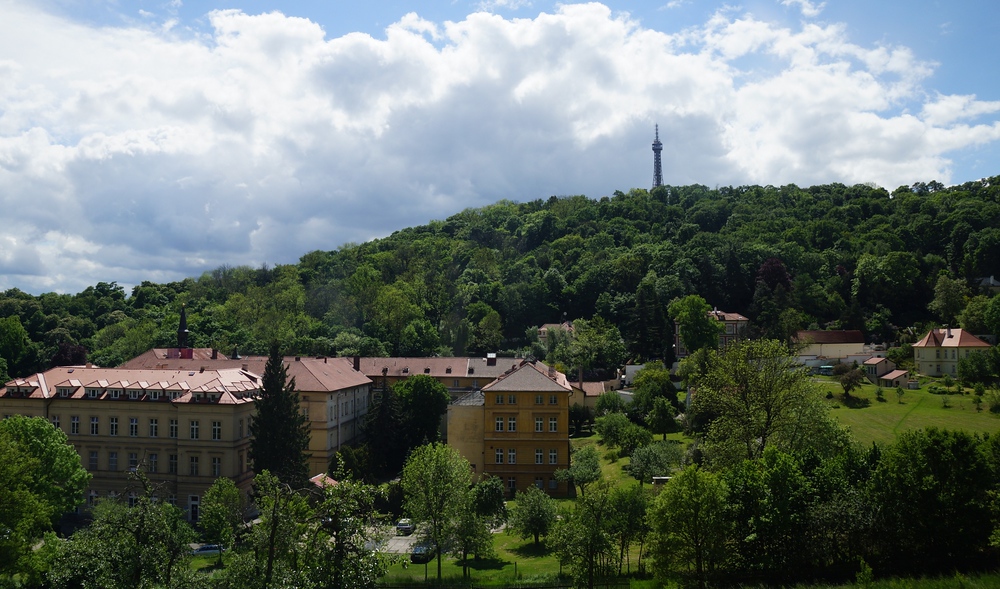
19) Petrin Tower
Petrin Tower (Czech: Petřínská rozhledna) stands 63 meters high on a hill overlooking Prague. It strongly resembles the Eiffel Tower in Paris, and it’s a fairly easy climb to the top. Once used as a lookout and transmission tower, it is now a popular tourist attraction.
Climbing to the top of Petřín Tower rewards you with unparalleled panoramic views of Prague. From this vantage point, you can see the red rooftops of the Old Town, the majestic Prague Castle, the winding Vltava River, and the sprawling cityscape beyond. It’s a photographer’s dream.
Built in 1891 for the Jubilee Exhibition, Petřín Tower is a symbol of Prague’s rich history and architectural prowess. Modeled after the Eiffel Tower in Paris but at a smaller scale, it stands as a testament to the city’s innovative spirit. A true marvel of 19th-century engineering.
The journey to the top is an adventure in itself. You can either take the funicular up Petřín Hill and walk to the tower or embark on a scenic hike through the lush, wooded paths of the hill. Once at the tower, climbing the 299 steps to the top is a thrilling experience.
Location
- Address: Petřínské sady 633, 118 00 Prague 1, Czech Republic
- Hours: The tower is open daily, with extended hours in the summer. Check the official website for current timings.
Getting There
- Funicular: Take the funicular from Újezd station to the Petřín Hill stop. From there, it’s a short walk to the tower.
- Public Transport: Trams 9, 12, 15, 20, and 22 stop at Újezd, where you can catch the funicular.
- Walking: If you’re up for a hike, you can walk up Petřín Hill from various entry points, enjoying the scenic paths.
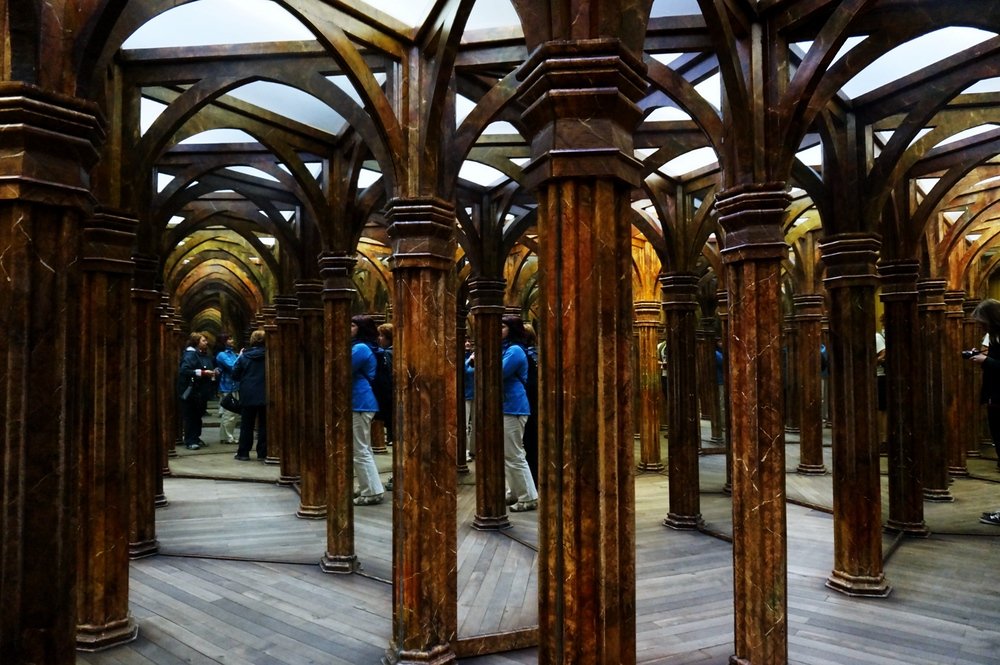
20) Maze of Mirrors
Another activity to consider is the Maze of Mirrors. It is more geared towards children but it is still a fun thing to do. As a quirky attraction it is certainly not a must see/do activity; however, if you’re nearby Petrin Tower it is worth a visit.
Visiting “Bludiště” is like stepping into a world where reality bends and reflections play tricks on your mind. The Maze of Mirrors is designed to disorient and amuse. Built in 1891 for the Jubilee Exhibition, the Maze of Mirrors carries a piece of Prague’s history.
The exterior resembles a small castle, adding a touch of fairy-tale charm to the experience. Inside, the mirrors and dioramas transport you back in time, offering a glimpse into the playful side of Prague’s cultural heritage.
Unlike traditional sightseeing, the Maze of Mirrors is an interactive experience that encourages you to engage and participate. You’ll be actively exploring, laughing, and enjoying the challenge of finding your way out. It’s a refreshing break from the typical tourist activities you’ll find in Prague.
Getting There
- Funicular: Take the funicular from Újezd station to the Petřín Hill stop. The Maze of Mirrors is a short walk from there.
- Public Transport: Trams 9, 12, 15, 20, and 22 stop at Újezd, where you can catch the funicular.
- Walking: If you prefer a scenic hike, you can walk up Petřín Hill from various entry points, enjoying the lush paths and gardens.
Visitor Tips
- Keep an Eye on Children: The maze can be disorienting, so ensure young children are supervised.
- Respect the Mirrors: Avoid touching the mirrors too much to keep them clean and clear for everyone.
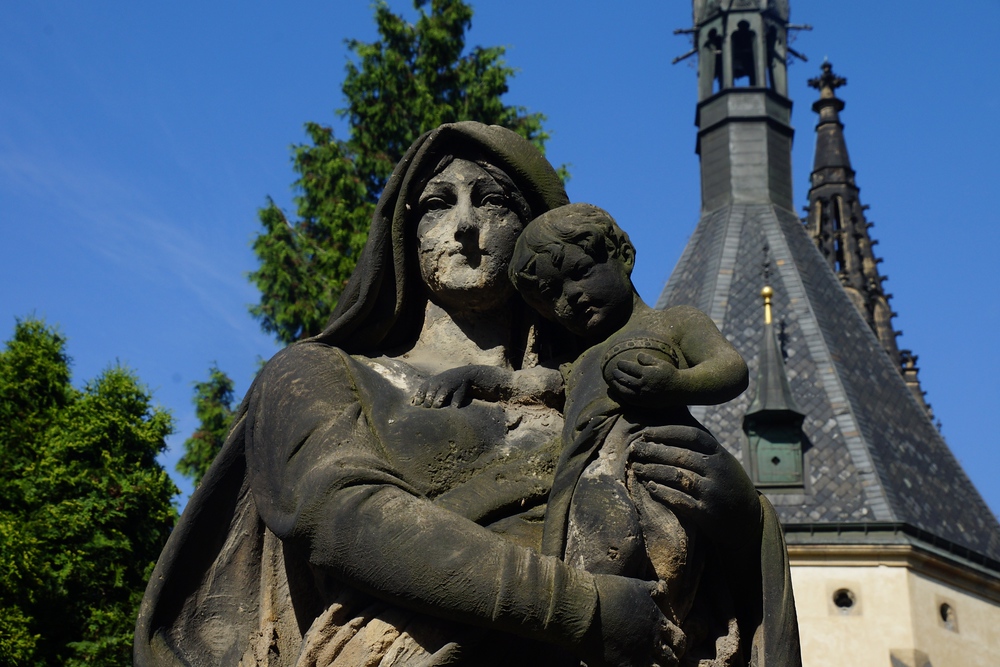
21) Vysehrad
Vyšehrad is a historical fort located in the city of Prague. Here you’ll find the ruins of Prague’s other castle built in the 10th century, as well as a cemetery that’s the resting place for many of Prague’s artists and great thinkers. Rotunda of St. Martin, just happens to be Prague’s oldest surviving building dating back to the 11th century. According to some, Vysehrad is the first area of settlement in the city.
Vysehrad is steeped in legend and history. According to ancient tales, it was the original seat of Czech royalty before Prague Castle. The fortress houses the Basilica of St. Peter and St. Paul, a beautiful neo-Gothic church with striking interiors and intricate stained glass windows. The Vysehrad Cemetery, the final resting place of many Czech cultural icons, adds a touch of solemn reverence to your visit.
One of the highlights of Vysehrad is the panoramic view it offers. From the fortress walls, you can enjoy sweeping vistas of the Vltava River, Prague Castle, and the city’s skyline. It’s a perfect spot for photography or simply soaking in the beauty of Prague from a different perspective.
Plan Your Visit
- Hours: Vysehrad is open year-round, with the park accessible 24/7. The Basilica of St. Peter and St. Paul and other interiors have specific visiting hours, so check ahead for timing.
- Tickets: Entry to the grounds is free. Some attractions within Vysehrad, such as the Basilica and the casemates, may require a ticket.
Getting There
- Metro: Take Line C (red line) to Vysehrad station. It’s a short walk from there.
- Tram: Trams 7, 18, and 24 stop at Vysehrad. From the tram stop, it’s a pleasant walk to the fortress.
- Walking: If you’re staying nearby, walking to Vysehrad is an enjoyable option, offering scenic views along the way.
Visitor Tips
- Early Arrival: Visit early in the morning or later in the afternoon for a more peaceful experience.
- Pack a Picnic: Consider bringing a picnic to enjoy in the gardens. It’s a wonderful way to soak in the serene atmosphere.
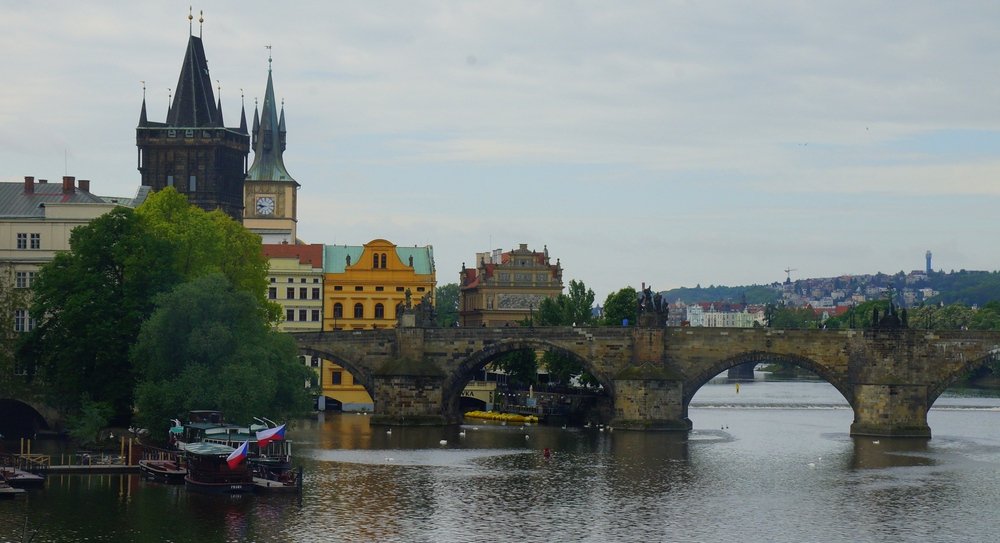
22) Vltava River Cruise
For a leisurely afternoon, hop on a river cruise and enjoy a scenic journey down the Vltava River. Considering crossing one of its 18 bridges – the most famous being Charles Bridge (mentioned above).
You’ll glide past some of Prague’s most iconic sights. Marvel at the majestic Prague Castle perched on the hill, the intricate details of the Charles Bridge, and the historic Old Town. The river provides a front-row seat to the city’s architectural wonders.
There’s a cruise for every preference and occasion. Choose from short, leisurely cruises, romantic dinner cruises with live music, or even adventurous night cruises that showcase the city illuminated under the stars. Each option offers a unique way to enjoy the river and the surrounding scenery.
Choose Your Cruise
- Day Cruises: Perfect for sightseeing and enjoying the daylight views of Prague.
- Dinner Cruises: Offers a romantic setting with a meal and live music.
- Night Cruises: Experience the city lights and the magical atmosphere of Prague after dark.
Getting There
- Dock Locations: Cruises typically depart from docks near Charles Bridge and Old Town. Check the specific departure point when booking.
- Public Transport: Use trams or the metro to get to the nearest station. The docks are usually within walking distance from major transport hubs.
Visitor Tips
- Dress Comfortably: Depending on the weather, bring a light jacket or sweater for cooler evenings.
- Arrive Early: Arriving 15-20 minutes early ensures you have enough time to find your boat and get settled.
- Check Inclusions: Some cruises include meals or drinks, so check what’s included in your ticket to make the most of your experience.
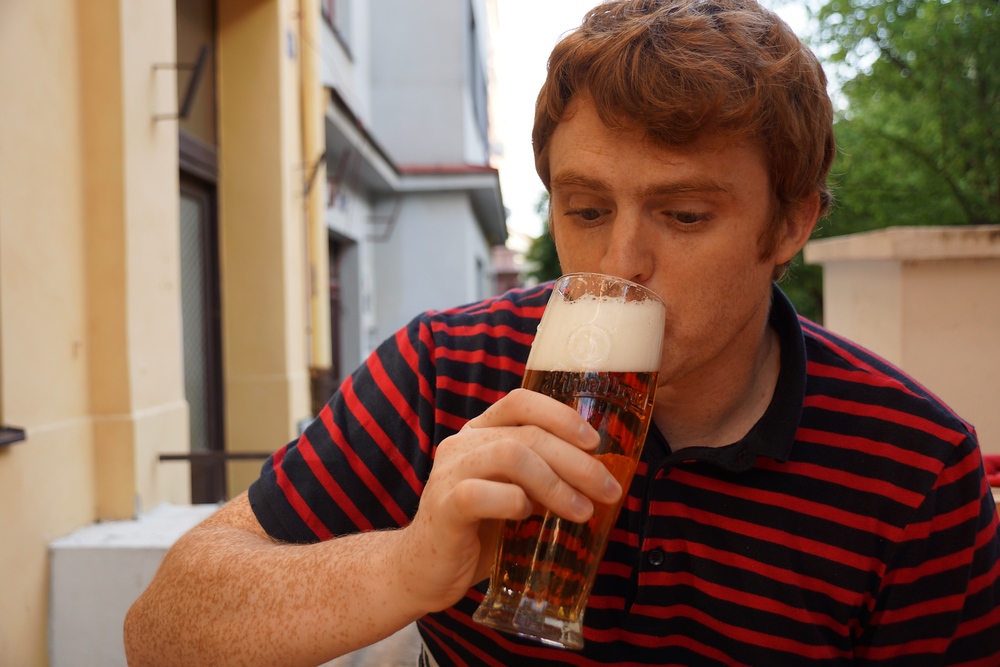
23) Drink Pilsner Beer
Pilsner beer is a Czech institution. This pale lager is known for its golden color, high level of foam and a nice light taste. Deriving its name from the city of Plzen, Bohemia when it was first made back in 1842, the original company is still making it today. The best thing about it is that it is cheaper than water and cola. You better believe I had more than just one 😉
Pilsner beer has deep roots in Czech history. The first Pilsner, Pilsner Urquell, was brewed in 1842 in the city of Plzeň (Pilsen), setting the standard for lagers worldwide. Known for its golden color and crisp, refreshing flavor, Pilsner beer is a delight to the senses. The combination of Saaz hops, soft Bohemian water, and pale malts creates a balanced, slightly bitter taste that’s incredibly satisfying.
Prague’s beer culture is vibrant and lively. From traditional beer halls and cozy pubs to modern breweries, the city offers countless places to enjoy a cold Pilsner. You can find it on tap in almost every bar, pub, and restaurant.
Visit Traditional Beer Halls
- U Fleků: One of Prague’s oldest beer halls, offering a historic setting and a great selection of beers.
- Lokál: Known for its fresh, unpasteurized Pilsner Urquell served straight from the tank.
Explore Modern Breweries
- Dva Kohouti: A trendy brewery offering a variety of craft beers, including their take on the classic Pilsner.
- BeerGeek Bar: Known for its extensive selection of both local and international beers on tap.
Visitor Tips
- Try Fresh Pilsner: Look for pubs that serve tank beer (unpasteurized Pilsner Urquell) for the freshest experience.
- Pair with Food: Enhance your tasting experience by pairing Pilsner beer with traditional Czech dishes.
- Engage with Locals: Don’t hesitate to strike up a conversation with locals. They often have great recommendations for where to enjoy the best beer.
- Take a Tour: Brewery tours provide valuable insights into the brewing process and the history of Pilsner beer.

24) Jeleni Prikop Park
After all that sightseeing around the city, you’ll likely want some time to relax. The Jeleni Prikop Park located right behind Prague Castle is a great place for a picnic or a little nap on the grass. It is one of Prague’s many quiet ‘green escapes’ from the heavily frequented tourist attractions.
Deer Moat has a rich history dating back to the 16th century when it was used as a hunting ground for deer. Today, it remains a significant part of Prague’s historical landscape. The park is a lush green oasis filled with diverse flora and fauna. Strolling through its winding paths, you’ll encounter scenic views, charming wooden bridges, and the soothing sounds of a babbling brook.
Situated in the shadow of Prague Castle, Jeleni Prikop Park offers stunning views of the castle’s impressive architecture. The contrast between the natural surroundings and the grandeur of the castle creates a magical ambiance. It’s perfect for photography and sightseeing.
Getting There
- From Prague Castle: Walk through the castle grounds and follow the signs to Jeleni Prikop Park. The park is located on the north side of the castle complex.
- Public Transport: Take tram number 22 to the “Pražský hrad” stop, then follow the signs to the park. Alternatively, the park can be accessed from the Malostranská metro station (Line A).
Visitor Tips
- Pack a Picnic: Bring along a picnic to enjoy in the park’s tranquil setting.
- Respect Nature: Help keep the park clean and beautiful by disposing of your trash properly.

25) Concert at the National Museum
Here is a cool little fact. Even though the National Museum is currently closed you can still attend musical performances in the evening. You can see if you’re interested in any of the concerts and that way you can get a peek inside of the National Museum.
The National Museum’s concert hall is a marvel of neo-Renaissance architecture. With its grand domed ceilings, intricate frescoes, and opulent interiors, the setting itself is inspiring. The acoustics are also impeccable.
Czech Republic boasts a profound musical heritage, with composers like Antonín Dvořák and Bedřich Smetana hailing from this land. Concerts at the National Museum often feature their works.
From classical symphonies to contemporary ensembles, the concert schedule at the National Museum is diverse. You might find yourself enjoying a traditional orchestra one night and a modern jazz quartet the next.
Plan Ahead
- Check the Schedule: Visit the National Museum’s official website to view the concert schedule and book your tickets in advance. Popular performances can sell out quickly.
- Select Your Seat: Choose your seating preference based on the type of concert and your desired experience. The hall’s design ensures good visibility and acoustics from all angles.
Getting There
- Public Transport: The National Museum is well-connected by public transport. Take the metro (Line A or C) to the “Muzeum” station, or use trams 11 or 13 which stop nearby.
- Walking: If you’re staying in the city center, the museum is within walking distance from major hotels and attractions.
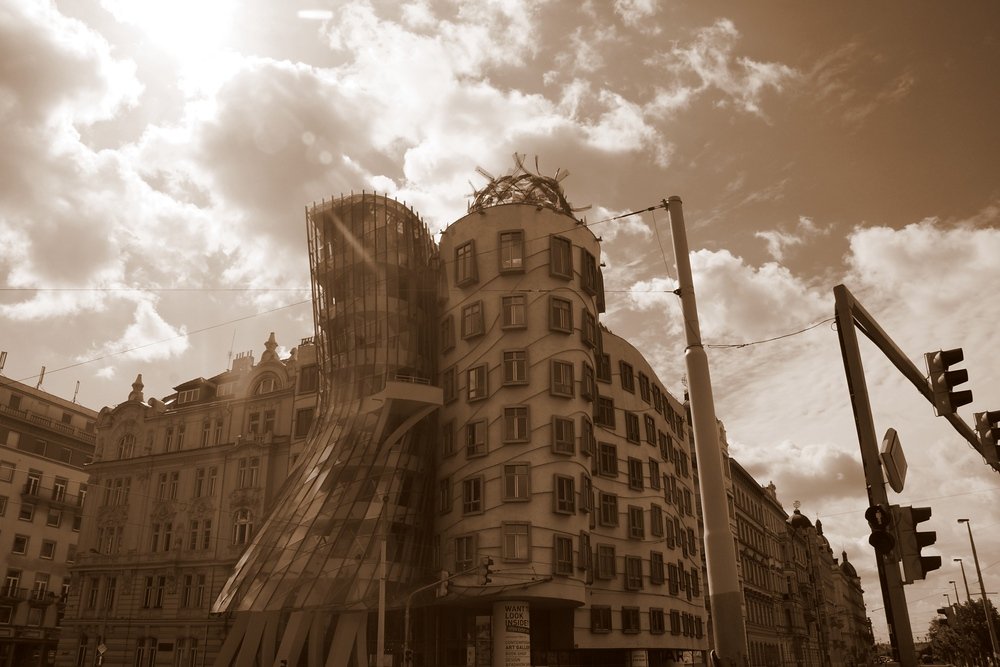
26) Dancing House
The Dancing House (Czech: Tančící důmis) a building which stands out from the rest, done in the deconstructionist style. Also known as the Fred and Ginger, it was completed in 1996 and is controversial for its non-traditional design in a city known for its Gothic, Baroque and Art Nouveau styles of architecture.
“Tančící dům,” is one of Prague’s most iconic modern landmarks. This architectural marvel, designed by Frank Gehry and Vlado Milunić, stands out amidst the city’s historic buildings with its unique, fluid design. Its design is inspired by the famous dancing duo Fred Astaire and Ginger Rogers.
The structure’s two towers seem to be in a graceful dance, with the glass tower curving and leaning against the stone tower. This dynamic form breaks the traditional architectural mold and showcases the creativity and boldness of modern design.
Plan Your Visit
- Opening Hours: The gallery and rooftop bar have specific opening hours. Check the official website for the most up-to-date information.
- Exhibitions: Look up current and upcoming exhibitions at the gallery to plan your visit around shows that interest you.
Getting There
- Public Transport: Take tram 17 or 21 to the “Jiráskovo náměstí” stop. The Dancing House is just a short walk from there.
- Walking: If you’re near the city center, it’s a pleasant walk along the Vltava River to reach the Dancing House.
Visitor Tips
- Timing: Visit during the late afternoon to catch the sunset from the rooftop terrace. The changing light adds a magical touch to the cityscape.
- Dining: Make a reservation at the rooftop restaurant to ensure you get a good seat with a view. The restaurant is popular, especially during peak tourist seasons.
- Photography: Bring a good camera or smartphone to capture the architectural details and panoramic views. The unique design offers numerous angles for creative shots.
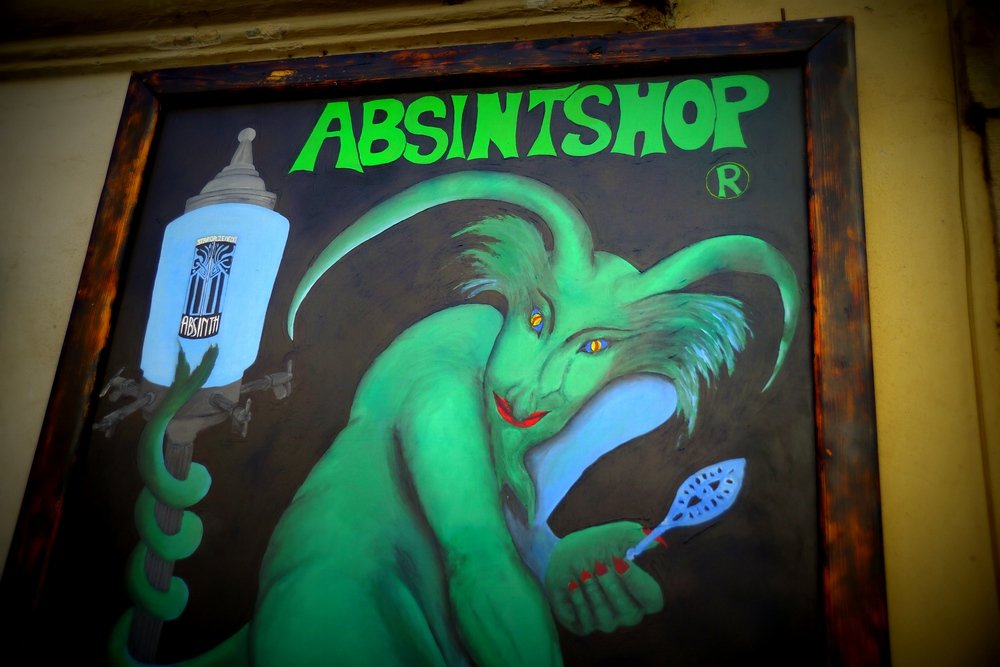
27) Try Absinthe
Anise is a flavored spirit that is extremely popular in Prague. This anise flavored spirit is potent coming in at 45-74% (90-148 proof) derived from flowers and botanicals. You can see it all over in all kinds of different stores. My initial impression was that it was quite tasty. I love any alcohol that tastes like licorice.
Known as the “Green Fairy,” Absinthe has been a part of European culture since the late 18th century. Its allure comes not only from its potent kick but also from its storied past, linked with famous artists and writers like Vincent van Gogh and Ernest Hemingway. Drinking absinthe in Prague gives you a taste of this intriguing history.
The absinthe drinking ritual is an experience in itself. Traditionally, absinthe is poured over a sugar cube placed on a slotted spoon. Cold water is then slowly dripped over the sugar, dissolving it into the drink and creating a cloudy, greenish louche. Absinthe bars in Prague often have a distinctive, bohemian atmosphere that transports you back to the days when this drink was at the center of artistic and literary circles.
Plan Your Visit
- Research Bars: Look up the best absinthe bars in Prague. Some popular options include Absintherie, Hemingway Bar, and Absinth Club.
- Check Opening Hours: Ensure the bars you want to visit are open. Some may have different hours, especially during holidays or weekends.
Visitor Tips
- Moderation: Absinthe is potent. Start with a small amount and enjoy it slowly. The ritual is about savoring the experience, not rushing it.
- Ask for Guidance: Don’t hesitate to ask the bartender for recommendations or a demonstration of the traditional absinthe ritual. Their expertise can enhance your experience.
- Mix it Up: Try different types of absinthe to appreciate the range of flavors. Some bars offer absinthe tasting flights, which are a great way to sample multiple varieties.

28) Mind Maze
There is an activity in Prague called Mind Maze. Basically, you’re locked in the Alchemist’s room for an hour and you have to go through clues to try and figure a way out. It is a mind game that involves a lot of teamwork and hashing out ideas together to solve the puzzle and get out of the room.
We ended up doing better than average (according to our guide at the end); however, we didn’t make it out of the room in 60 minutes. Apparently, only 1 in 5 does. Considering it was our first time playing I thought we did okay.
Getting There
- Address: Mind Maze is located at Tyršova 9, Prague 2.
- Public Transport: You can easily reach Mind Maze by metro (line C) to the I.P. Pavlova station, followed by a short walk.
- Walking: If you’re staying in the city center, it’s a pleasant walk to the venue.
Visitor Tips
- Arrive Early: Get there a bit early to settle in and receive instructions from the staff.
- Teamwork: Communicate and collaborate with your team. The best solutions often come from working together.
- Stay Calm: Don’t let the ticking clock stress you out. Focus on solving one puzzle at a time.
29) Segway Tour
If you tire of walking, Segways are a fun way to get around the cobbled streets. This is especially a good idea if you’ve been walking around the city for a few days in a row and your legs are getting sore.
With minimal effort, you can glide through the streets, alleys, and parks of Prague, taking in the breathtaking views without the fatigue that comes with walking or biking. It’s perfect for those who want to explore extensively without tiring out.
A Segway allows you to see more of Prague in less time. You can effortlessly move from one iconic landmark to another, whether it’s the Old Town Square, Charles Bridge, or the picturesque parks and hidden gems scattered throughout the city. This makes it an ideal choice for those with limited time.
Getting There
- Meeting Points: Segway tours usually start from a central location in Prague. Check the tour company’s website for specific meeting points and directions.
- Public Transport: Use Prague’s efficient public transport system to reach the starting point. Metro, trams, and buses can get you there quickly and conveniently.
- Walking: If you’re staying in the city center, many tour starting points are within walking distance.
30) Miniature Museum
Another cool thing you can do is visit the Miniature Museum where you can marvel at microscopic art miniatures by Anatolij Konenko. By wielding a magnifying glass you’ll discover a three dimensional model of the Eiffel Tower and a caravan of camels, just to name a few.
The Miniature Museum houses some of the most astonishingly detailed artworks you’ll ever see. From a camel caravan in the eye of a needle to a flea with golden horseshoes, each piece is a marvel of precision and skill. These tiny masterpieces challenge your perception of art and craftsmanship.
Where else can you see a minuscule copy of “The Lord’s Prayer” written on a human hair or an intricate model of the Eiffel Tower that fits on a pinhead? The exhibits are not only visually impressive but also provoke a sense of wonder and curiosity about the possibilities of human creativity and patience.
Getting There
- Location: The Miniature Museum is located at Strahov Monastery, Strahovské nádvoří 11, 118 00 Praha 1, Czech Republic.
- Public Transport: Take tram 22 to Pohořelec, then it’s a short walk to the Strahov Monastery complex.
- Walking: If you’re near Prague Castle or Petrin Hill, it’s a pleasant walk with beautiful views of the city.
Visitor Tips
- Check Opening Hours: The museum has specific opening hours, so check ahead to plan your visit.
- Combine Visits: Pair your visit with other nearby attractions like the Strahov Library and the Petrin Lookout Tower for a full day of exploration.
- Take Your Time: Give yourself ample time to view each exhibit thoroughly. The details are extraordinary and worth the extra time spent examining them.
- Accessibility: The museum is relatively small and easy to navigate, making it accessible for most visitors.
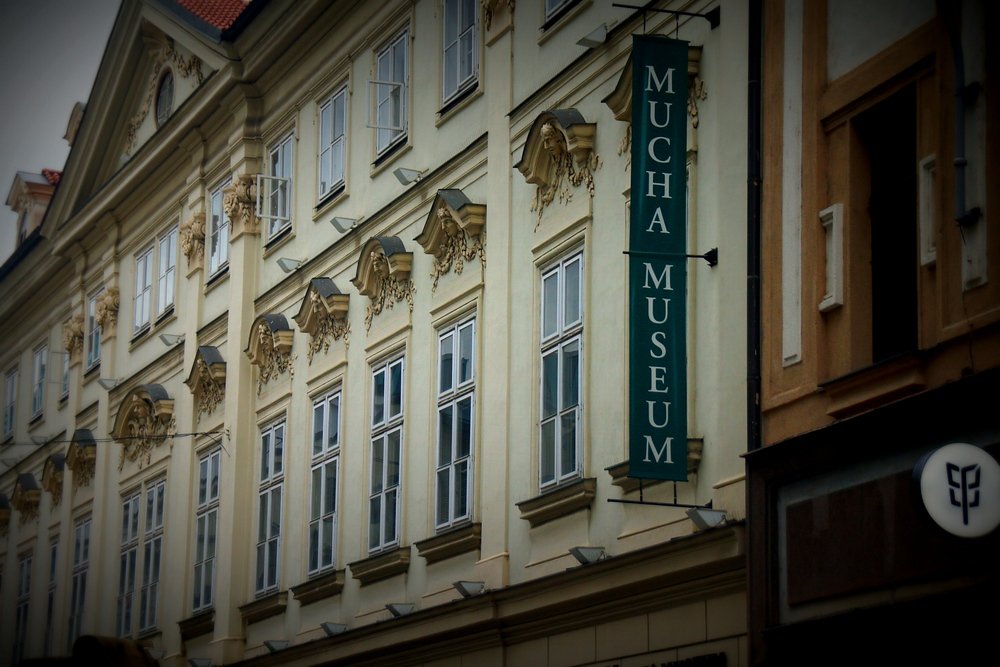
31) Mucha Museum
The Mucha Museum pays homage to Alphonse Mucha, and it’s a must visit if you enjoy art nouveau. Drawing from over 100 exhibits you’ll find paintings, drawings, pastels, photographs and more.
Alphonse Mucha’s work is synonymous with the Art Nouveau movement, characterized by intricate designs, flowing lines, and vibrant colors. The Mucha Museum houses an extensive collection of his most famous pieces. Tese include posters, paintings, drawings, and photographs. It’s a testament to Mucha’s extraordinary talent and artistic vision.
The museum also features personal artifacts and letters that provide deeper insight into Mucha’s life and creative process. These items offer a glimpse into the mind of the artist, making the visit a more intimate and enriching experience. Learning about his inspirations and challenges adds a layer of depth to the appreciation of his work.
Getting There
- Location: The Mucha Museum is located at Panská 7, 110 00 Prague 1, Czech Republic.
- Public Transport: Take the metro to Můstek (lines A and B) or to Muzeum (lines A and C), and it’s a short walk to the museum.
- Walking: If you’re in the city center, the museum is easily accessible on foot from major landmarks such as Wenceslas Square and the Old Town Square.
Visitor Tips
- Check Opening Hours: The museum has specific opening hours, so check ahead to plan your visit.
- Audio Guides: Consider using an audio guide to get the most out of your visit. These guides provide detailed explanations and context for the exhibits.
- Souvenir Shop: Don’t miss the museum shop, which offers a range of Mucha-themed souvenirs and art prints.
32) Take a Tram
The tram is an easy and inexpensive way to get around the city, plus if offers more of a local experience. We used public transportation frequently as a way to conserve our walking legs.
Taking a tram in Prague isn’t just about getting from point A to point B. It’s a quintessential part of the city’s charm. Prague’s trams meander through some of the most picturesque parts of the city. From the historic Old Town to the vibrant neighborhoods of Žižkov and Vinohrady, the tram routes provide an ever-changing backdrop of beautiful buildings, bustling squares, and serene parks.
The tram system in Prague has been in operation since 1875, making it one of the oldest in the world. Trams pass by iconic landmarks such as the National Theatre, Wenceslas Square, and the Prague Castle. The vintage trams, in particular, evoke a sense of nostalgia and transport you back in time.
With an extensive network covering the entire city, Prague’s trams are an efficient way to get around. They are frequent, reliable, and connect to major tourist attractions and neighborhoods. The convenience of hopping on and off at various stops makes exploring the city effortless and enjoyable.
Getting There
- Buy a Ticket: Purchase tickets at metro stations, tram stops, or from ticket machines. You can also buy tickets via mobile apps.
- Validate Your Ticket: Make sure to validate your ticket in the machine on the tram to avoid fines.
- Choose Your Route: Popular tram routes for sightseeing include Tram 22, which passes by major attractions like Prague Castle and the National Theatre.
Visitor Tips
- Avoid Peak Hours: For a more comfortable ride, avoid traveling during peak hours (7-9 AM and 4-6 PM).
- Keep Your Ticket: Hold onto your validated ticket for the duration of your ride as inspectors do frequent checks.
- Plan Your Route: Use a map or app to plan your route and know where you want to get on and off.
- Enjoy the View: Sit by the window for the best views of the city’s landmarks and scenery.
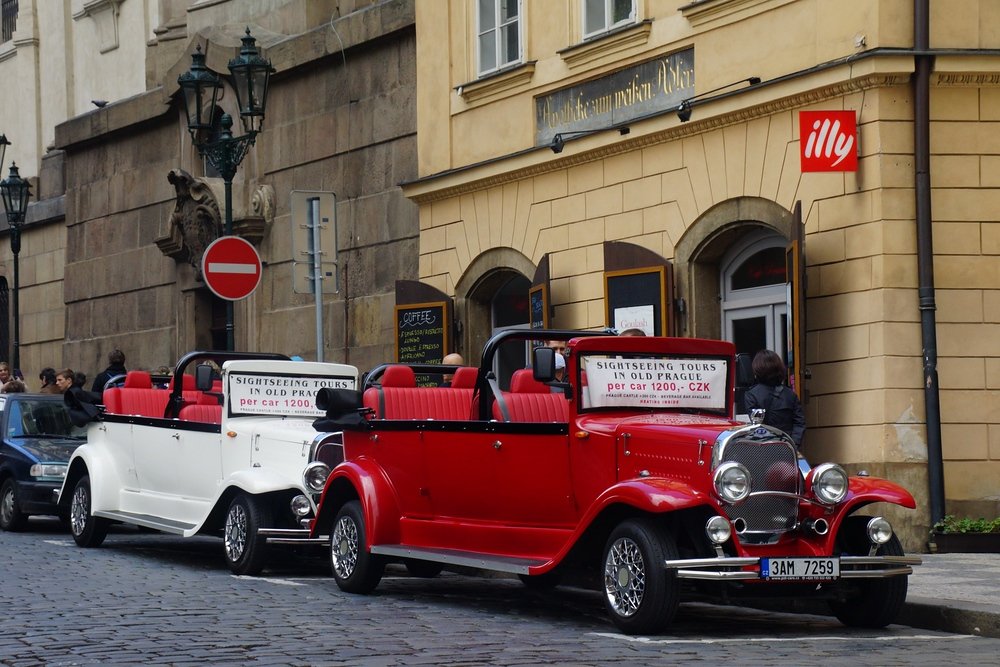
33) Luxury Car Tour
If you want to explore the city in a more fashionable way we’ve seen people taking luxury car tours. We noticed most 30 minute to one hour tours starting at around 40 Euros.
A luxury car tour often includes exclusive access to certain areas and personalized itineraries. Whether it’s a hidden gem off the beaten path or a VIP entrance to a popular attraction, these tours offer an elevated experience that standard tours simply can’t match.
Getting There
- Book in Advance: It’s best to book your luxury car tour ahead of time, especially during peak tourist seasons.
- Choose a Reputable Company: Look for companies with good reviews and a range of vehicles to choose from. Popular providers include Viator, GetYourGuide, and local luxury tour operators.
- Specify Your Preferences: When booking, mention any specific sites or experiences you want to include in your tour.
Visitor Tips
- Ask Questions: Make the most of your guide’s knowledge. Don’t hesitate to ask questions and learn more about Prague’s rich history and culture.
- Plan for Stops: Although you’ll be in a luxury car, plan for a few stops to stretch your legs and explore key sites on foot.

34) National Museum
One of the most important landmarks in the city, unfortunately the National Museum was closed because it is undergoing renovations; however, the collection itself is spread across ten museums here in Prague so you can still visit those.
The museum is a stunning example of neo-Renaissance architecture. Its grand facade, intricate interior details, and majestic dome make it a visual feast. Furthermore, the museum’s extensive collections cover a wide range of subjects, from natural history to anthropology and fine arts. You’ll find everything from ancient fossils and minerals to medieval artifacts and contemporary art.
The National Museum offers interactive displays and multimedia presentations that bring history to life. Whether it’s a 3D model of a prehistoric creature or a digital timeline of Czech history, these exhibits are engaging and educational, making the museum visit enjoyable for all ages.
Climb to the top of the museum’s dome for a breathtaking view of Prague. The panorama of Wenceslas Square and the city beyond is simply stunning, providing a perfect backdrop for memorable photos.
Getting There
- Location: The National Museum is located at Wenceslas Square 1700/68, 110 00 Nové Město, Prague.
- Public Transport: Take the Metro (Line A or C) to Muzeum station, which is right next to the museum. Alternatively, several trams stop at nearby stations.
- Walking: If you’re staying in the city center, the museum is a pleasant walk from most central hotels.
Visitor Tips
- Plan Your Visit: Allocate at least 2-3 hours to explore the museum thoroughly. Check the museum’s website for special exhibits or events.
- Guided Tours: Consider joining a guided tour for a more in-depth experience.
- Refreshments: The museum has a café where you can take a break and enjoy a coffee or a snack.
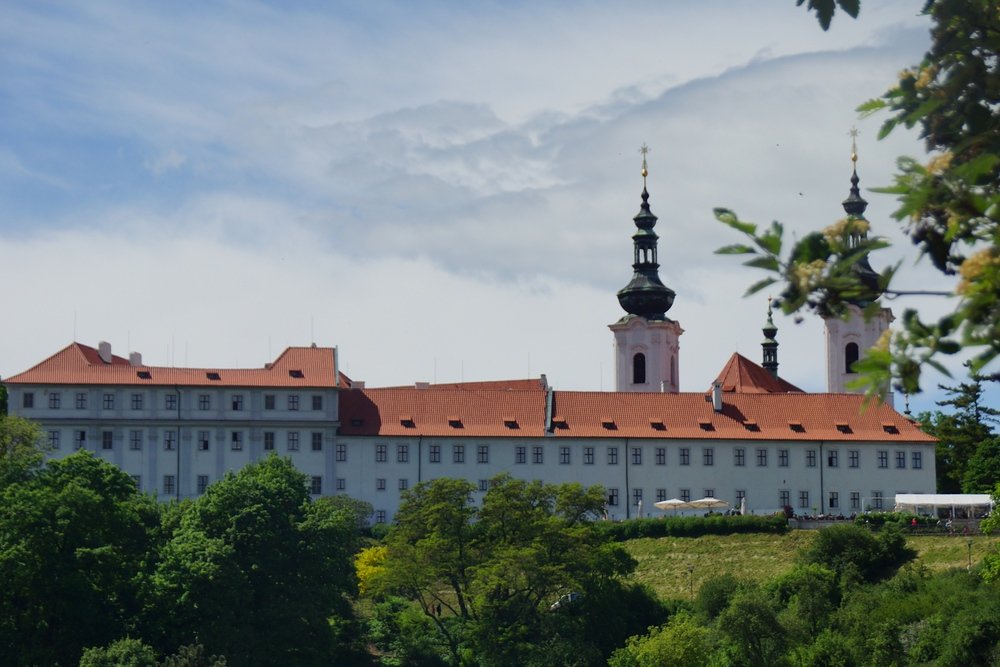
35) Strahov Monastery
It’s a bit of steep walk to reach the monastery, but the long climb offers great views of the city below. Also, the library inside the monastery is certainly worth a peek!
Founded in 1143, Strahov Monastery is a masterpiece of Baroque architecture. Its stunning facade, intricate carvings, and grand interiors transport visitors back in time. The library halls, adorned with ceiling frescoes and filled with ancient manuscripts, are a particular highlight, showcasing the monastery’s dedication to knowledge and beauty.
The Strahov Library is one of the most beautiful libraries in the world. It consists of the Theological Hall and the Philosophical Hall, each brimming with rare books, globes, and ornate decorations. The frescoes on the ceilings are works of art in their own right.
Getting There
- Location: Strahovské nádvoří 1/132, 118 00 Praha 1, Czechia.
- Public Transport: Take tram number 22 to the Pohořelec stop. From there, it’s a short walk to the monastery.
- Walking: If you’re up for a bit of exercise, you can walk up Petřín Hill from the Lesser Town. The scenic route offers beautiful views along the way.
Visitor Tips
- Accessibility: The monastery has some steep paths and stairs, so comfortable walking shoes are recommended.
- Respect the Silence: Maintain a respectful quietness, especially in the library and church areas.
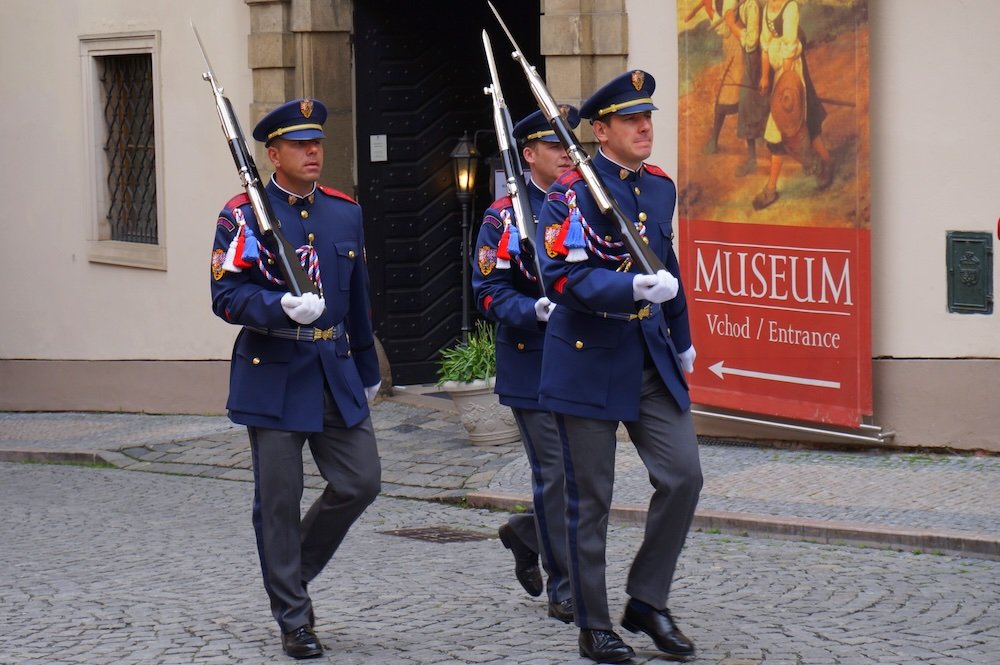
Planning Your Prague Trip: Make That One Week Count
Spending a week in Prague is fantastic because you can move beyond “top 35 things to do” mode and actually settle into the city. You’re not just ticking off sights; you’re learning tram routes, finding a favorite café, and figuring out which beer garden has your sunset.
Here is the practical part: trip-planning focused, with neighbourhood breakdowns, sample itineraries, budgets, and decision-matrix style tables to help you quickly choose what fits your travel style.
Where to Stay in Prague: Neighbourhoods at a Glance
Prague is compact. Yet each area has a very different feel. Picking the right neighbourhood can make your week in the city feel calm and cozy…or like a full-on party.
Quick Neighbourhood Decision Matrix
| Area | Vibe | Best For | Noise Level | Transit Access | Why Pick It? |
|---|---|---|---|---|---|
| Old Town | Classic, touristy, lively | First-timers, short stays | High | Excellent | Walk to many top sights in minutes |
| Malá Strana | Romantic, historic, hilly | Couples, photographers | Medium | Good | Close to castle, cobbled lanes, river views |
| New Town | Urban, busy, nightlife | Night owls, foodies | High | Excellent | Easy access to bars, restaurants, and tram lines |
| Vinohrady | Local, leafy, café culture | Longer stays, digital nomads | Low–Medium | Very good | Parks, farmers’ market, more local pricing |
| Žižkov | Gritty-cool, young, artsy | Budget travellers, bar-hoppers | Medium–High | Good | Cheap eats, local pubs, alternative feel |
| Holešovice | Up-and-coming, creative | Repeat visitors, gallery lovers | Medium | Good | Fewer tourists, modern vibe, DOX, markets |
How to Pick Your Base
Old Town (Staré Město)
If this is your first visit and you want that “open your door and you’re in a postcard” experience, Old Town makes life easy.
- You’ll be walking distance to the Astronomical Clock, Old Town Square, and Charles Bridge.
- Expect crowds, especially mid-day, and higher prices on food and accommodation.
- Great if you’re only in Prague for a few nights and don’t mind a bit of noise.
Malá Strana (Lesser Town)
Think red roofs, lantern-lit streets, and the castle above you.
- Perfect for couples or anyone craving a romantic, old-world atmosphere.
- You’re close to Prague Castle, Nový Svět, and the riverside swans.
- Evenings are quieter than Old Town, but daytime still gets busy.
New Town (Nové Město)
Despite the name, it’s still historic—but with more of a city buzz.
- Good balance of sights and modern life: Wenceslas Square, shops, restaurants.
- Handy for trams and metro; easy to reach everywhere.
- Ideal if you want evening options without staying in a party street.
Vinohrady
If you like staying where locals live, Vinohrady is your happy place.
- Tree-lined streets, wine bars, and the Jiřího z Poděbrad farmers’ market.
- Great for a week-long stay where you don’t mind a 10–20 minute tram ride to the center.
- Feels more relaxed, with better value in cafés and restaurants.
Žižkov and Holešovice
If you’re on a budget or you’ve visited Prague before:
- Žižkov: lots of pubs, slightly rough-around-the-edges, with great views from the TV Tower.
- Holešovice: home to DOX Centre for Contemporary Art, markets, and a growing food scene.
Getting Around Prague: Trams, Tickets, and Walking Legs
You already know walking is the best way to really feel Prague, but the city’s public transport is so good you should absolutely use it to save energy.
Public Transport Basics
- The same ticket works on trams, metro, and buses within the city.
- You buy a ticket, validate it once when you first board, and then you’re covered for that time period.
- Inspectors are active, so keep your validated ticket handy.
Common Ticket Durations (just as a planning guide)
- Short rides: handy for crossing the river or hopping up to the castle.
- 24-hour / multi-day passes: perfect if you’re taking trams multiple times per day or staying outside the main centre.
When to Walk vs Tram vs Metro
Walk
- Anywhere between Old Town, Malá Strana, and the river.
- When wandering between Charles Bridge, the Lennon Wall, and Kampa Island.
- Even walking up to the castle can be worth the extra leg burn for the views.
Take the Tram
- To reach Prague Castle via tram 22 or 23, then walk down through the castle complex.
- To get to Vinohrady and the Jiřího z Poděbrad market area.
- To explore Žižkov and the TV Tower without an uphill slog.
Use the Metro
- To connect quickly between New Town, Old Town, and outlying neighbourhoods.
- For longer cross-city jumps, like heading towards Vyšehrad or out to bus/train stations.
Practical Transport Tips
- Screenshot a tram / metro map to keep offline on your phone.
- Use a maps app to mark your hotel and key tram stops.
- If you’re staying in a more residential area, learn your “home” tram line on day one.
Rough Budgeting for Prague: What a Day Might Cost
Let’s get real. Everyone’s spending is different. Here’s a simple planning-level table to help you set expectations. Amounts are approximate and just for comparison.
Daily Budget Snapshot (Per Person)
| Style | Accommodation (per night) | Food & Drink | Transport | Sights & Extras | Total (approx.) |
|---|---|---|---|---|---|
| Budget | Low-cost hotel / hostel | Cook / cheap eats, beer in pubs | Pass / a few tickets | Free walks, a few paid sights | Lower range |
| Mid-range | Comfortable hotel / apartment | Mix of restaurants, café stops, beers | Day pass or multiple rides | Several museum entries, cruise, tower | Medium range |
| Splashy | Boutique / luxury hotel | Sit-down meals, cocktails, tastings | Taxi occasionally + passes | Concerts, private tours, fine dining | Higher range |
To keep Prague affordable:
- Mix free views (Vyšehrad, Jelení Příkop, Charles Bridge at sunrise) with a handful of paid experiences (castle ticket, tower climbs, a cruise).
- Eat at lunch menus in local restaurants rather than dinner in main tourist squares.
- Grab beer in neighbourhood pubs rather than big, tourist-oriented bars off the main squares.
Best Time to Visit Prague: Seasons in Plain Language
You can visit Prague year-round. Your experience changes a lot with the weather and crowds.
Spring (April–May)
- Flowering trees, milder temps, and fewer crowds than summer.
- Great for walking and photography without intense heat.
- Pack layers and a light rain jacket.
Summer (June–August)
- Long days, busy streets, and lots of outdoor events.
- Perfect for beer gardens, river cruises, and evening strolls.
- Expect higher prices and heavier crowds around top sights—go early or late to the hotspots.
Autumn (September–October)
- Cooler air, golden leaves, and a more relaxed vibe after peak season.
- Fantastic for city walks, tower climbs, and cozy pub evenings.
- Layers again: you’ll be warm while walking but might want a jacket at night.
Winter (November–March)
- Darker, colder, but magical around Christmas markets.
- Great if you like fewer tourists, moody photos, and ducking into cafés and museums.
- Bring a warm coat, hat, and gloves—cobblestones feel colder than you’d think.
Sample Prague Itineraries: Build Your Week
You already have 35 ideas; now let’s turn them into workable days. Think of these as plug-and-play frameworks.
Classic 3-Day Intro to Prague
Day 1: Old Town and the River
- Start at Old Town Square and the Astronomical Clock.
- Wander the narrow streets towards Charles Bridge.
- Cross over, feed the swans, and explore Kampa Island.
- Sunset from the bridge or one of the nearby riverfront spots.
- Evening: hearty Czech dinner and a first Pilsner.
Day 2: Castle District and Surroundings
- Tram up to Prague Castle; visit St. Vitus, Golden Lane, and the castle courtyards.
- Drop down to Nový Svět for a quieter, village-like feel.
- Continue through Malá Strana, John Lennon Wall, and hidden courtyards.
- Optional: Kafka Museum if you’re into literature and a bit of surrealism.
- Evening beers in a traditional pub.
Day 3: New Town and Vinohrady
- Explore Wenceslas Square and the National Museum.
- Head to Vinohrady for coffee, cafés, and the farmers’ market at Jiřího z Poděbrad (when running).
- Afternoon rest in a park or by the river.
- Evening: try a concert at the National Museum or another music venue.
5–7 Days: Deeper Prague
Once you’ve done the “big hits”, use the extra days to slow down and get a feel for neighbourhoods.
Ideas to Work In
- Petřín Hill: funicular or hike up, visit Petřín Tower and the Mirror Maze.
- Vyšehrad: quieter fortress, atmospheric cemetery, great views over the river.
- Žižkov: climb (or ride up to) the TV Tower, check out local pubs.
- Museums: mix and match—Mucha Museum, Museum of Communism, KGB Museum, Miniature Museum.
- Themed activities: escape room at Mind Maze, luxury car tour, or just ride trams for a DIY city circuit.
Simple Planning Trick
Build each day around one “anchor” area:
- Morning: main sight or neighbourhood (Castle, Old Town, Vyšehrad).
- Afternoon: café break + another sight in the same general zone.
- Evening: dinner and drinks within walking distance of your hotel.
That way you’re not zig-zagging across the city just because everything looks tempting on a map.
Eating and Drinking in Prague: Beyond Goulash and Trdelník
You’ve already sorted out goulash and street snacks. But for a week in Prague you have plenty more to cover.
Breakfast and Coffee
Prague’s café culture is underrated:
- Look for local bakeries for pastries and simple breakfasts.
- Independent cafés in Vinohrady and New Town are great for slow mornings or laptop sessions.
- Traditional coffee houses give you a glimpse of old-world charm and are perfect for a mid-morning break between sightseeing.
Lunch Strategy
- Use lunch to try heavier Czech dishes like goulash or svíčková (marinated beef with creamy sauce and dumplings) when prices are a bit lower and your energy needs a boost.
- Mid-day is a good time to slip into popular restaurants that are slammed at dinner.
- If you’re travelling in summer, consider a picnic: swing by a supermarket or farmers’ market, grab cheese, bread, fruit, and have an easy meal in a park overlooking the city.
Dinner and Evenings
In the evenings you can lean fully into the “beer and hearty food” side of Prague:
- Aim for one or two “destination” dinners where you book ahead and linger over multiple courses.
- On other nights, keep it simple: local pubs with goulash, schnitzel, sausages, or grilled meats.
- If you’re into nightlife, New Town and Žižkov have a more energetic bar scene; if you prefer mellow, stick to wine bars and pubs in Vinohrady or Malá Strana.
Beer, Absinthe, and Everything in Between
Prague is a dream if you like a drink with a story.
- Pilsner is your baseline; try it in both classic beer halls and modern craft bars to see how the feel changes.
- Absinthe is for a one-or-two-drink experience, not an all-night session. Treat it like a ritual rather than a challenge.
- Always eat something substantial when you’re sampling stronger spirits—your future self will thank you the next morning when you’re climbing yet another tower.
Extra Experiences to Round Out Your Week
Once the obvious things are ticked off, you’ve still got plenty of ways to keep Prague feeling fresh.
Slow Travel Moments
Sometimes the best memories come from doing “nothing special” but doing it with intention.
- Sit by the river with a takeaway coffee and just watch boats, trams, and people go by.
- Pick a single neighbourhood—Vinohrady, Holešovice, Žižkov—and spend a whole afternoon with no agenda except wandering and stopping at places that catch your eye.
- Build in at least one early morning and one late night walk across Charles Bridge to see how different the city feels.
Day Trip Ideas (If You Have Extra Time)
If your Prague stay stretches beyond a week or you’re the “never stop moving” type, you can sprinkle in a day trip:
- A medieval town with narrow streets and castle views.
- A gothic cathedral and bone church combo if you like darker, more atmospheric sights.
- A castle-focused day for more fairytale architecture and countryside views.
| Day trip | One-way travel time | Vibe | Main focus | Best for |
|---|---|---|---|---|
| Kutná Hora | 1 hr train | Medieval, quirky | Bone church, cathedrals | First-time visitors, photographers |
| Karlštejn Castle | 40–50 min train | Storybook countryside | Hilltop castle, forest walks | Couples, families, castle lovers |
| Český Krumlov | 2.5–3 hrs bus | Fairytale riverside | Old town, castle, rafting | Long day/overnight, slow travelers |
| Plzeň (Pilsen) | 1.5 hrs train | Beer heritage | Pilsner Urquell brewery tour | Beer fans, foodies |
| Terezín Memorial | 1–1.5 hrs bus | Somber, reflective | WWII ghetto & fortress | History buffs, responsible travelers |
You don’t need to over-plan these. Prague’s train and bus connections are straightforward. Stations are easy to reach by tram or metro.
Common Mistakes to Avoid in Prague
A few simple tweaks can make your trip smoother:
Over-Packing the Day
Prague looks small on the map so it’s tempting to cram five or six big sights into each day. The reality?
- Narrow streets + cobblestones + hills = slower walking.
- Give yourself breathing room for unplanned stops and random discoveries.
Only Seeing the City Mid-Day
Some of the best moments happen when the crowds thin:
- Early mornings: softer light, quieter squares, locals heading to work.
- Late evenings: the city glows, and you can finally walk across Charles Bridge without shuffling.
Eating Only in Tourist Squares
The views are lovely, but the prices and quality often don’t match what you’ll find just a few streets away.
- Use the main squares as your navigation points, then dip into side alleys for actual meals.
Ignoring Your Feet
Cobbled streets are beautiful but punishing.
- Bring good walking shoes, consider a blister kit, and don’t feel guilty about hopping on a tram for a “lazy” ride home.
Prague Summer Trip FAQ: Plan The Perfect One-Week Stay In The Czech Capital
Is one week in Prague too long or just right?
Just right. With seven days you can see the “greatest hits” (Prague Castle, Charles Bridge, Old Town, Jewish Quarter) without rushing, plus spend time in neighborhoods like Vinohrady, Žižkov, and Holešovice. A week also gives you breathing room for markets, museums, lazy beer garden evenings, and even a day trip if you’re keen.
Where should I stay in Prague for a first visit?
If it’s your first time and you want to step out the door and be in the middle of it all, Old Town is the easiest base. Malá Strana is perfect if you want romance, cobbled streets, and quick access to the castle with slightly calmer evenings. New Town works for food and nightlife. If you prefer a more local, café-and-park vibe, Vinohrady is a great pick and still very well connected by tram and metro.
Is Prague expensive compared to other European cities?
Prague sits in the “sweet spot.” It’s not as cheap as it was 20 years ago, but it’s still noticeably more affordable than cities like Paris, London, or Zurich. You can drink excellent beer for the price of a soft drink, eat hearty Czech food without destroying your budget, and use public transport for very little. Your costs will spike mainly around accommodation in the most touristy areas and on paid tours.
Do I need to pre-book Prague Castle, Petřín Tower, and other big sights?
For most sights you can buy tickets on the day, especially outside of peak summer weekends. That said, if you’re traveling in July or August and you hate queues, pre-booking timed tickets or guided tours for Prague Castle, the popular river dinner cruises, and escape rooms like Mind Maze is smart. Petřín Tower and the funicular can usually be done same-day, but expect lines in the middle of the afternoon.
Are Prague trams easy to use for tourists?
Yes. Trams are one of the easiest ways to get around Prague. You buy a timed ticket (for example 30 or 90 minutes, or a day pass), validate it once when you board the first time, and then simply hop on and off within the validity period. Stops and routes are clearly marked, announcements are frequent, and many classic sightseeing routes (like Tram 22) pass several major attractions in one go.
What’s the best way to get from Prague airport to the city centre?
Most visitors choose either public transport or a pre-booked transfer. Public transport usually means an airport bus that connects to the metro, then a short ride into the centre. It’s inexpensive and straightforward if you’re comfortable with luggage on public transit. If you’re arriving late, tired, or with kids, a pre-booked taxi or shuttle to your hotel is worth the extra money for a smooth, door-to-door ride.
Can I drink the tap water and is street food safe in Prague?
Yes on both counts. Tap water in Prague is generally safe to drink, so you can refill a reusable bottle instead of constantly buying plastic. Street food and market snacks are also safe as long as you stick to busy stalls with good turnover and food that’s hot and freshly prepared. As always, trust your nose and eyes—if something looks sad and old, skip it.
How much walking will I realistically do in Prague in a day?
A lot. Prague is very walkable, but that also means you can easily clock 15,000–20,000 steps in a sightseeing day without noticing. Add in cobblestones, hills up to the castle and Petřín, and lots of staircases, and it’s a leg workout. Comfortable shoes are non-negotiable, and using trams to “save your steps” between far-flung areas can make a huge difference over the course of a week.
Is Prague safe at night in the main areas?
Generally, yes. Prague’s central neighborhoods are considered safe, and you’ll see lots of people out in the evening around Old Town, New Town, and along the river. The main things to watch for are pickpockets in crowds, the odd pushy bar promoter, and the usual late-night drunk antics in party streets. Keep an eye on your bag, avoid dodgy currency exchange places, and use licensed taxis or rideshares if you’re heading home late.
Do I need cash or is card widely accepted in Prague?
Card is widely accepted and you can tap to pay in most restaurants, cafes, museums, and supermarkets. That said, it’s still handy to have a bit of Czech koruna on you for small bakeries, local markets, public toilets, or the occasional street stall. Use ATMs attached to banks rather than random “Euronet”-type machines, and always decline dynamic currency conversion if offered.
What’s a realistic daily budget for Prague in summer?
Very roughly: a budget traveller can get by on about €50–70 per day if staying in a hostel, eating simply, and using public transport. Mid-range travellers often sit in the €80–130 range, with a private room, a restaurant meal or two, a couple of beers, and one paid attraction or tour daily. If you’re going for apartment hotels, tasting menus, and premium tours like luxury car experiences, you’ll want to budget comfortably above that.
Are the big attractions in Prague kid-friendly?
Many of them are. Petřín Hill, the funicular, the Maze of Mirrors, river cruises, feeding swans by the Vltava, and markets like Farmářské Tržiště Jiřák are all great with kids. Prague Castle, the Astronomical Clock, and Charles Bridge can work too, as long as you pace things and build in snack and park breaks. Very small children may get bored in more serious museums (like the Museum of Communism or the Kafka Museum), so mix those with lighter stops.
What should I absolutely book in advance in Prague in summer?
In high season, it’s worth pre-booking: popular river dinner cruises, escape rooms like Mind Maze, Segway or e-bike tours, special concerts at the National Museum or classical venues, and any guided Prague Castle or Jewish Quarter tours you really care about. Accommodation in the most popular neighbourhoods also fills up quickly for summer weekends and Christmas markets, so lock that in early too.
Are river cruises, Segways and luxury car tours really worth it?
It depends on your style and budget. A simple daytime river cruise is a relaxing way to see the city from a new angle and is good value for most visitors. Segway or e-bike tours are great if your legs are shot from walking and you want to cover a lot of ground quickly. Luxury car tours are more of a splurge experience—fun if you’re celebrating something or just love that old-school glamour, but not essential to enjoy Prague.
What are the must-eat Czech dishes (and where should I try them)?
Start with goulash with bread dumplings, svíčková (braised beef in creamy sauce), hearty soups, and anything involving roast pork or duck with cabbage and dumplings. Snack on trdelník for dessert and wash it all down with a proper Pilsner. Look for traditional pubs and beer halls rather than the most touristy spots right on Old Town Square—places a few streets back or in Vinohrady and Žižkov often have better prices and more local atmosphere.
Wrapping Up Your Prague Plan
Think of Prague as a layered city:
- First layer: iconic views—castle, bridge, towers, and squares.
- Second layer: neighbourhoods—Vinohrady markets, Žižkov pubs, leafy parks, riverside walks.
- Third layer: your own routines—morning coffee spot, sunset viewpoint, go-to tram route.
With a week in the Golden City, you have time to enjoy all three. Use the main post’s 35 ideas as your menu, then let this add-on guide help you turn them into a trip that feels lived-in, not rushed.
Prague Final Thoughts
And that sums up our visit to Prague! Our 1 week in the city left us bedazzled! It’s a place that we’d be happy to revisit again in the near future.
What are some of your favorite things to do in the city? Please let us know in the comment section below.

Hi Samuel, greetings from Prague 🙂 Excellent list! Indeed not too touristy. I am especially happy that you mention: Goulash is actually Hungarian food.
And excellent photos!
Would you please tell me what theme are you using? I am looking for something similar. Thanks in advance.
Prague is a very beautiful city! I loved spending 4 days there but it seems that I missed a lot of things! great post, congrats :))
I’ve never been to Prague but its on our list for 2015 – I really want to go as it looks beautiful!
Hey Samuel. Great list – we’ve been in Prague now for almost 2 months and the city has grown on us. Actually, our favorite thing to date, something you haven’t mentioned, was long the other side of the river started at the Letná Beer Garden: http://bbqboy.net/photo-essay-pragues-scenic-walk/. The views over the city are amazing and it’s a park-like atmosphere with few people. Especially gorgeous in the late afternoon.
You suggestion of the Dancing House is a good one. I read that you need reservations just to get in the elevator (there’s a fancy restaurant and rooftop bar). We went to check it out and were able to get to the top without anyone stopping us – great views from the top of the river and the castle. Maybe we just got lucky. But I recommend to anyone that it’s worth a shot…
Still working through your list. By the time we’re done here (a month left) I’ll be doing my own list of things to do here. Just a great city. And the transport is great (and, as you mention, tram rides especially are fun)
Good job,
Frank (bbqboy)
PS. Some of the Czech towns great as well. Cesky Krumlov and Kutna Hora very pretty. And, costs about half of what they are in Canada…
Thanks for sharing your experience and article Frank!
Hi Samuel,
I promised I’d do my own list of things to do in Prague: http://bbqboy.net/50-things-prague/. We spent 3 months there and fell in love with the city. We’ll be back one day. Thanks for your suggestion of the fort of Vyšehrad, it wasn’t listed in my guide book and we would have missed it. Ended up being a special day.
Frank
I actually agree with Marta. I went to Prague in the summer and found it beautiful, but too touristy for my taste. Perhaps your idea of visiting at another time of year would change my mind.
Prague looks like so much fun! I might be going at some point in the near future so this is definitely getting bookmarked, thanks for the tips! 🙂
Done, done…..damn, I miss Prague so much! One of the most charming cities I’ve visited with mouthwatering food, I definitely need to go back there. Beautiful photos! 🙂
Thanks Vlad! It is a city I’d enjoy revisiting as well 🙂
Quite a list Samuel – makes me want to go to Prague even more!
I have managed to visit a few Eastern Europen cities, my favourite so far being Tallinn; but I’ve not made it to Prague yet despite it being on my bucket list for years.
Obviously it is no longer Europe’s great secret any more – just how touristy has it become these days?
what an excellent tour, there’s so many things to do and explore in Prague, will definitely make it there some day
I find this guy with pretty good tips. He even create tour map. Take a look: http://hitchhikershandbook.com/2013/12/31/prague-free-walking-tour-sightseeing-guide/
I really had no idea Prague had so much to offer, I’d often been told it was an amazing city but never had anyone elaborate on it.
Thanks for an awesome list!
Thanks Nick! It is definitely a city worth exploring 🙂
Great list of things to do while in Prague! I’ve always wanted to go there – looks like such a beautiful city.
Thanks Jayme!
I highly recommend it if you get a chance to go 🙂
What a list! Many are already on my wish list for when I get to Prague, but it looks like I’ll need to add a few more.
Thanks Andrea! I hope this gives you a few new ideas to consider 🙂
We’d love to visit Prague – especially the Prague Castle. And the goulash sounds very tasty too :-). Great list of things to do, which we’ve bookmarked for when we (hopefully) visit .
Thanks! Those are two of my personal favorites – especially eating Goulash 😉
Ha, very nice…now that I’ve been I can relate to so many of these. Love wandering up the hill, though I went along the side of the wall up the steep hill trying to find a way on top (epically failed and cut up by thorns). John Lennon wall was really cool. Wandering around was just overall fun. The beer…YES the beer. Did you go to the Prague Beer Museum? Amazing. and my favorite as the bratwurst from the street stands.
Cool to hear about your experiences in Prague Ryan 🙂 We didn’t get to the Prague Beer Museum! Wow, so many things to do 🙂
For Prague born traveler and fan of yours is glad to hear you enjoyed it! Pretty impressive list for one week. There is much more hidden places to visit and be there just with locals.
1. You can even visit same places but in different hour then travel agencies take groups there. Prague Castle is great about 9pm (close at 11pm) with beautiful view over night Prague.
2. go to Slovansky ostrov (island on Vltava river) where is Zofin garden (and palace) and you can rent a small boat.
3. great place for chill out is Naplavka. 5min. walk from Slovansky island (just turn right when you leave island and walk 5min, unce you get to white building Manes modern art galery go along the river and you´re there). Its great place just beside the river. You can walk, ride a bike or inlines, run, or just sit under the umbrella and enjoy your beer in Bajkazyl while you have your bike fixed.
4. Unce you´re there you can take a boat ride to Prague ZOO (belong to top 10 ZOO in the world). Use this link and google translater 🙂 : http://www.paroplavba.cz/lodi-z-rasinova-nabrezi-do-zoo
5. across the river on west river bank is small (200m long) sand beach. Use this link, info in from 2009 but the beach is still there: http://www.momondo.com/blogs/mashak/archive/2009/06/18/beach-life-in-the-metropole-prague.aspx
and much much more you can do in Prague and feal like you´re between locals.
(sorry for all those link, its easier then explain it)
6. In Prague is also big Couchsurfing comunity. There is always someone to meet who will take you to places where the locals go.
P.s.: just little correction about Franz Kafka. All Czech will tell you he was a Czech writer …..
Hope it was helpful
Enjoy it in Prague
Vit
Thanks Vit!!!
These are fantastic additions! I’m glad I didn’t do a bad job of showcasing the awesome city where you are from 🙂
I thank you Samuel for being inspirational for other travelers 🙂
I did enjoy Prague, but I found it a bit too touristy to my taste. I do admit that I only spent 2 days there and it is not enough to explore the whole city (I haven’t seen at least half of the things you are writing about here), but since I love to photograph I found the crowds unbearable to take a good shot, unless it was late and night or early in the morning. If I ever get a chance I do want to come back, but I think I will pick winter to do so.
Marta, I think coming in winter would be a great idea. In fact, I’d love to travel around Europe that time of year.